Refresh
Watch live today: NASA tours Percy’s epic Mars panorama
The team of scientists behind the first HD Mars panorama from Perseverance will discuss the new imagery in a live Q&A today (Feb. 25) at 4 p.m. EST (2100 GMT). You can watch it live here:
[embedded content]
Watch Perseverance’s sky crane crash into Mars
Rest In Pieces, sky crane!
The Perseverance Mars rover’s “sky crane” descent stage made the ultimate sacrifice last week, and we now have a photo to memorialize the flying robot’s heroic death. Check it out below:

Read the full story: NASA’s Perseverance rover watched as its sky crane crashed on Mars (photo)
Perseverance snaps its 1st Mars panorama
NASA has revealed the first panoramic photo of Mars from the Perseverance rover, and the view is amazing!

And, in case you missed the live reveal earlier today, here is the amazing, high-definition video that Perseverance captured during its epic landing inside Mars’ Jezero Crater on Thursday (Feb. 18):
Full story: Watch Perseverance land on Mars in this epic first-of-its-kind video
NASA unveiling Mars landing video
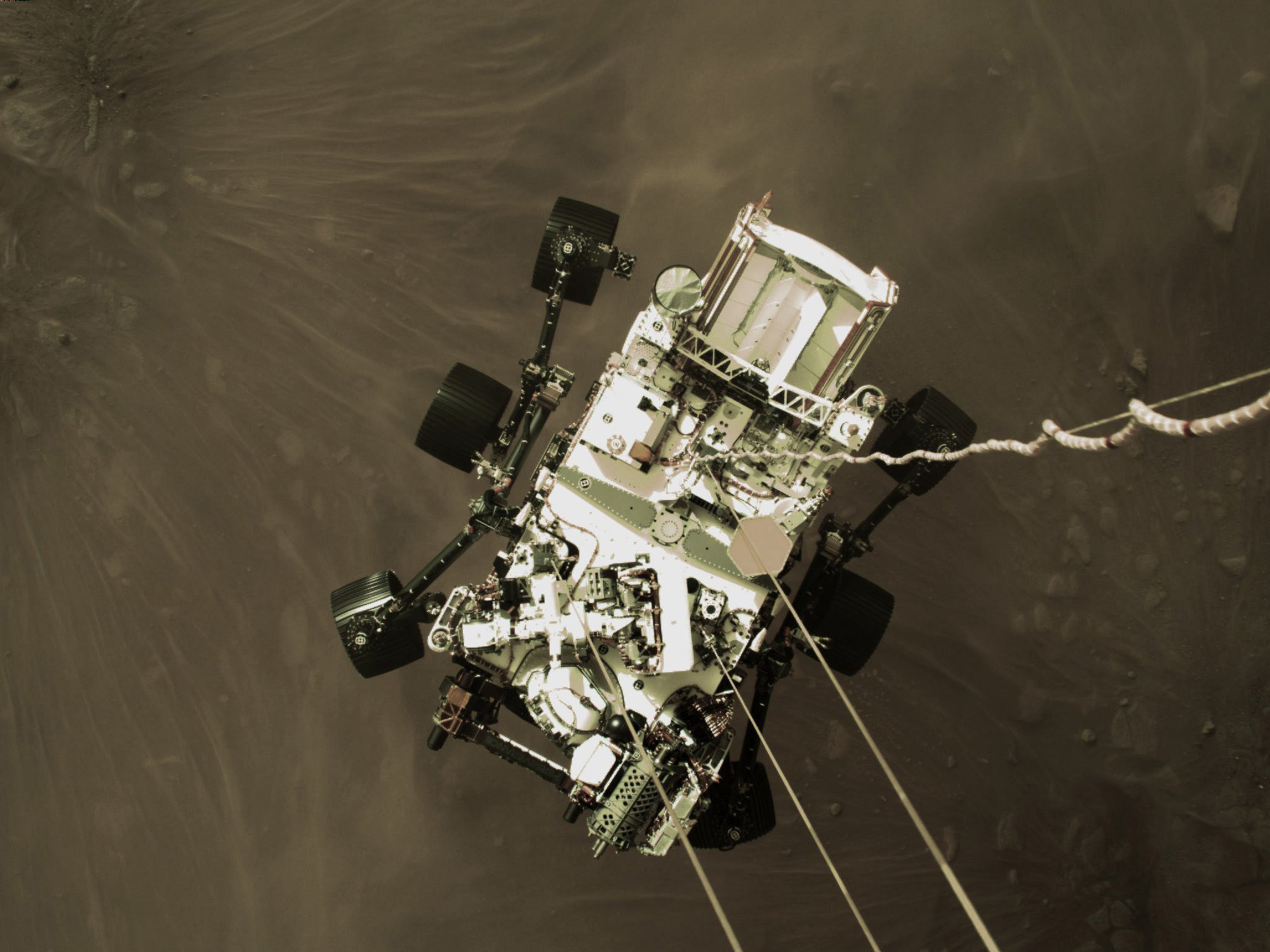
Hold on to your butts. NASA will unveil dramatic landing video from the Perseverance rover on Mars today in a press conference at 2 p.m. EST (1900 GMT). You’ll be able to watch it live here, on this page, as well as on Space.com’s homepage and NASA’s YouTube feed.
In other news, the White House released a video on Saturday of president Joe Biden congratulating the Perseverance rover team for the Mars landing success. You can watch it here.
Mars helicopter Ingenuity reports in

The Mars helicopter Ingenuity on the Perseverance rover has phoned home to report it is healthy in the belly of the rover, according to NASA engineers at the Jet Propulsion Laboratory.
NASA received a signal late on Friday (Feb. 19) at 6:30 p.m. EST (2130 GMT) from Ingenuity stating that the helicopter and its charging station are operating as planned.
“There are two big-ticket items we are looking for in the data: the state of charge of Ingenuity’s batteries as well as confirmation the base station is operating as designed, commanding heaters to turn off and on to keep the helicopter’s electronics within an expected range,” Tim Canham, Ingenuity Mars Helicopter operations lead at JPL, said in a statement. “Both appear to be working great. With this positive report, we will move forward with tomorrow’s charge of the helicopter’s batteries.” — Tariq Malik
NASA unveils amazing Mars rover landing photos
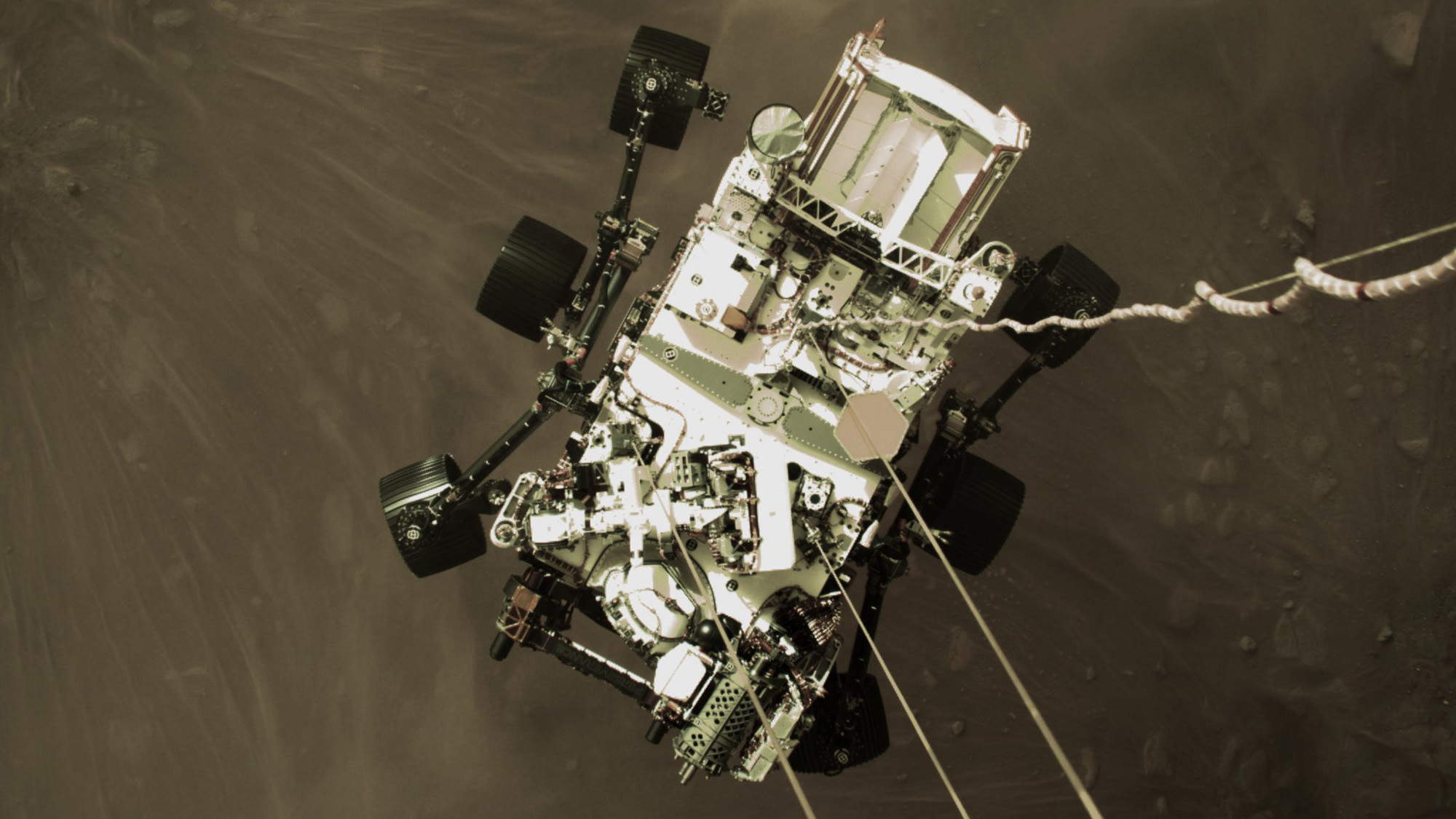
NASA engineers are thrilled at their first color photos of Mars from the Perseverance rover, which they released in a press conference today.
The crown jewel is the image above showing a view of Perseverance rover dangling from its sky crane while hovering 2 meters above the surface of Mars.
“Seeing the rover hanging underneath our skycrane, this rocket powered jetpack, is something we’ve never seen before,” Aaron Stehura, the rover’s deputy phase lead for entry, descent and landing, said in a press conference today. “Our team was awestruck.”
Perseverance team members also unveiled the first color photo of Mars from the surface by the rover. You can see that below.
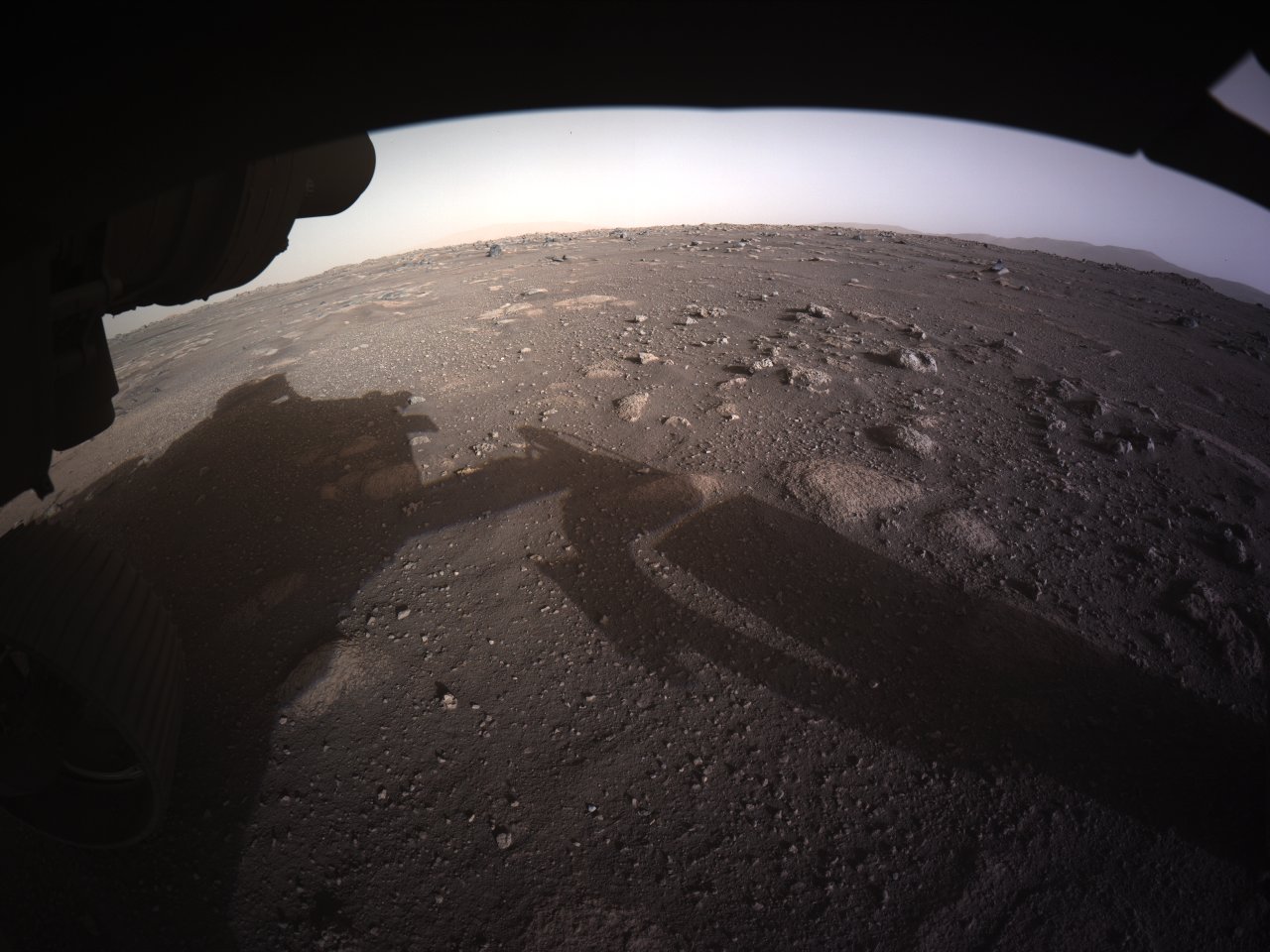
The image shows a view of Mars to the rear of Perseverance as seen from a navigation camera once its cover was successfully jettisoned.
NASA’s Mars Reconnaissance Orbiter also captured a stunning view of Perseverance from space. Its photo shows Perseverance hanging from its parachute, the largest ever built for another world, as it plunged through the Martian atmosphere. You can see that here.
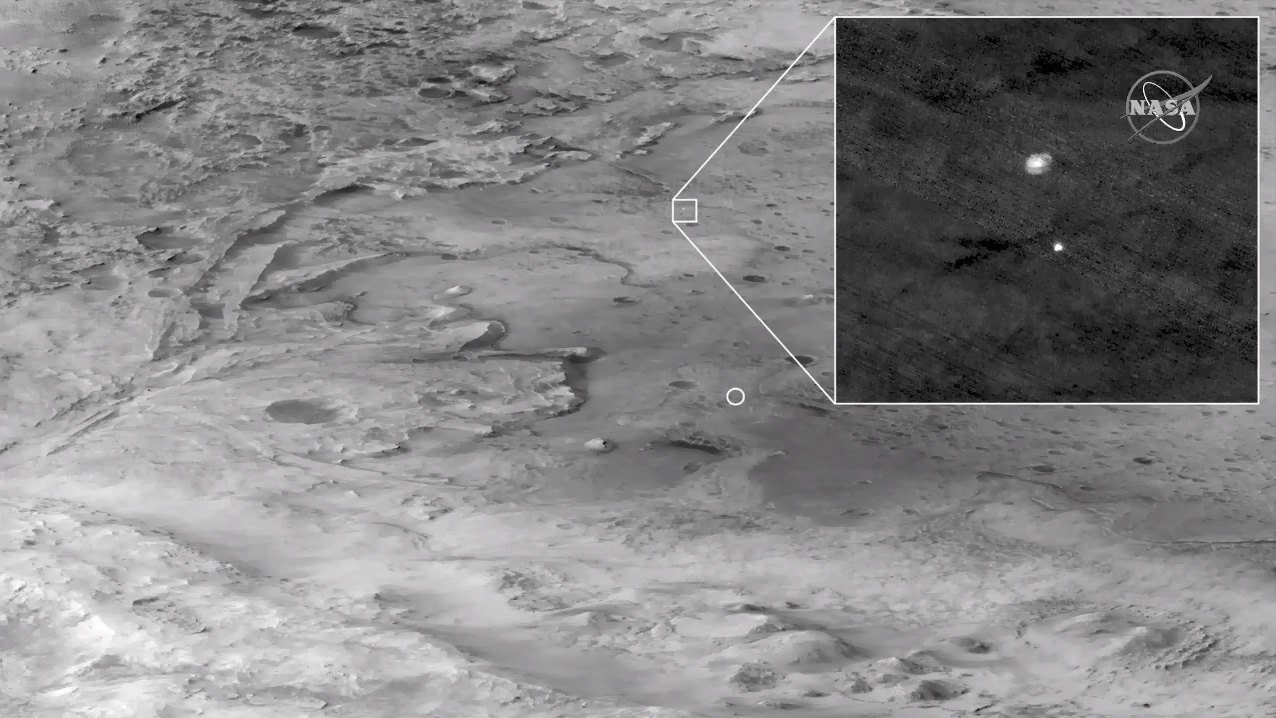
We’ll have an update from NASA’s press conference today shortly.
LIVE: NASA update on Mars rover Perseverance
Editor’s note: NASA’s press conference has ended. A video of key announcements is embedded above.
NASA is offering a live update right now on the status of the Perseverance rover on Mars. Watch live!
Perseverance’s 1st full sol on Mars
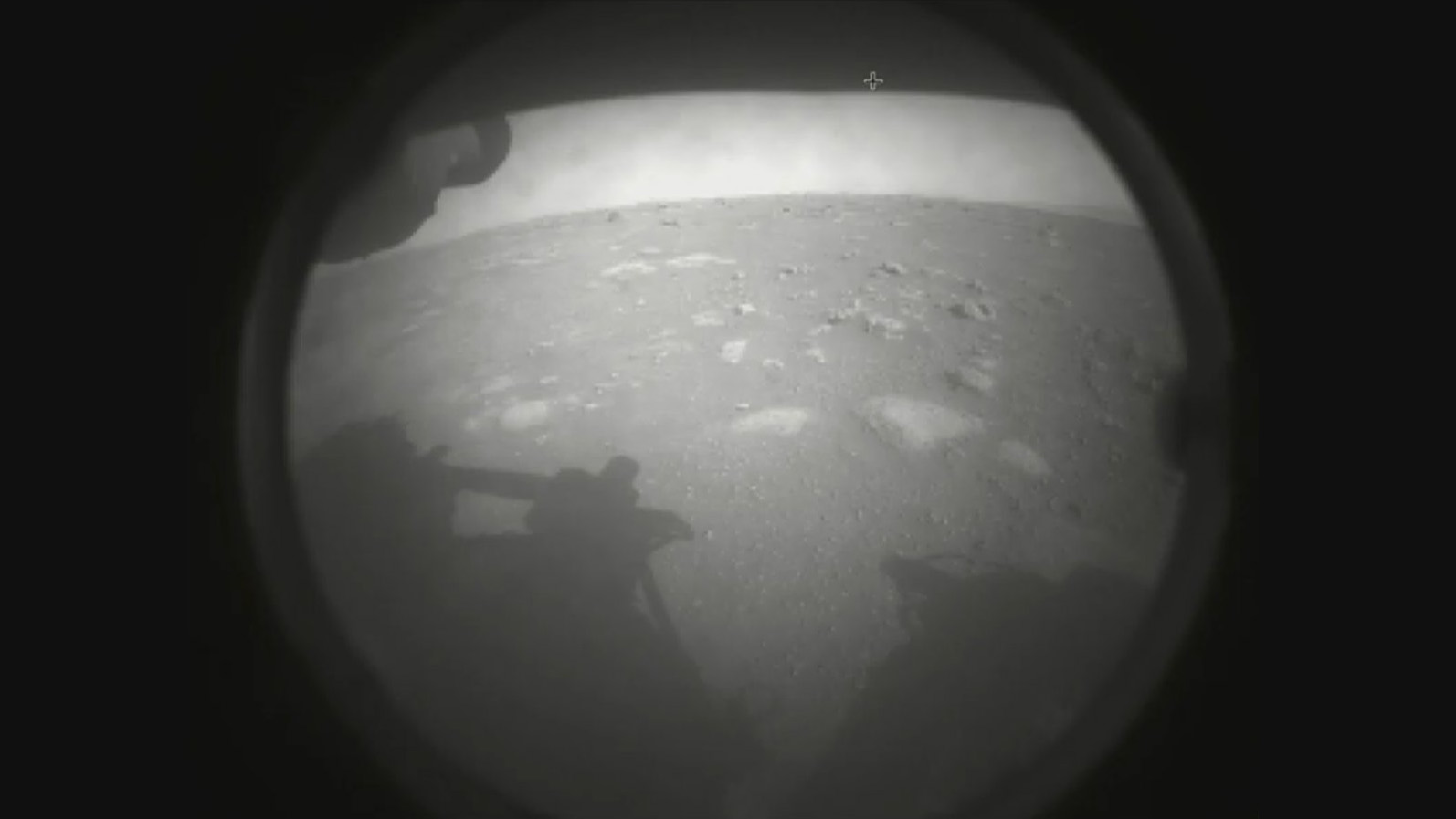
With Perseverance successfully on Mars, the work begins to power up the rover’s main science instruments but it will be some time before the rover begins driving on the Red Planet.
Senior writer Mike Wall takes a look at what’s next on Mars for Perseverance here. The rover landed without its camera mast and robotic arm deployed, so some tasks include unfolding all of its stowed instruments and getting them ready for work on Mars.
Meanwhile, our senior writer Chelsea Gohd has a great look inside a Mars landing during a pandemic and how NASA overcame COVID-19 challenges and took some time to honor healthcare workers on Mars.
President Biden, VP Harris hail Mars landing
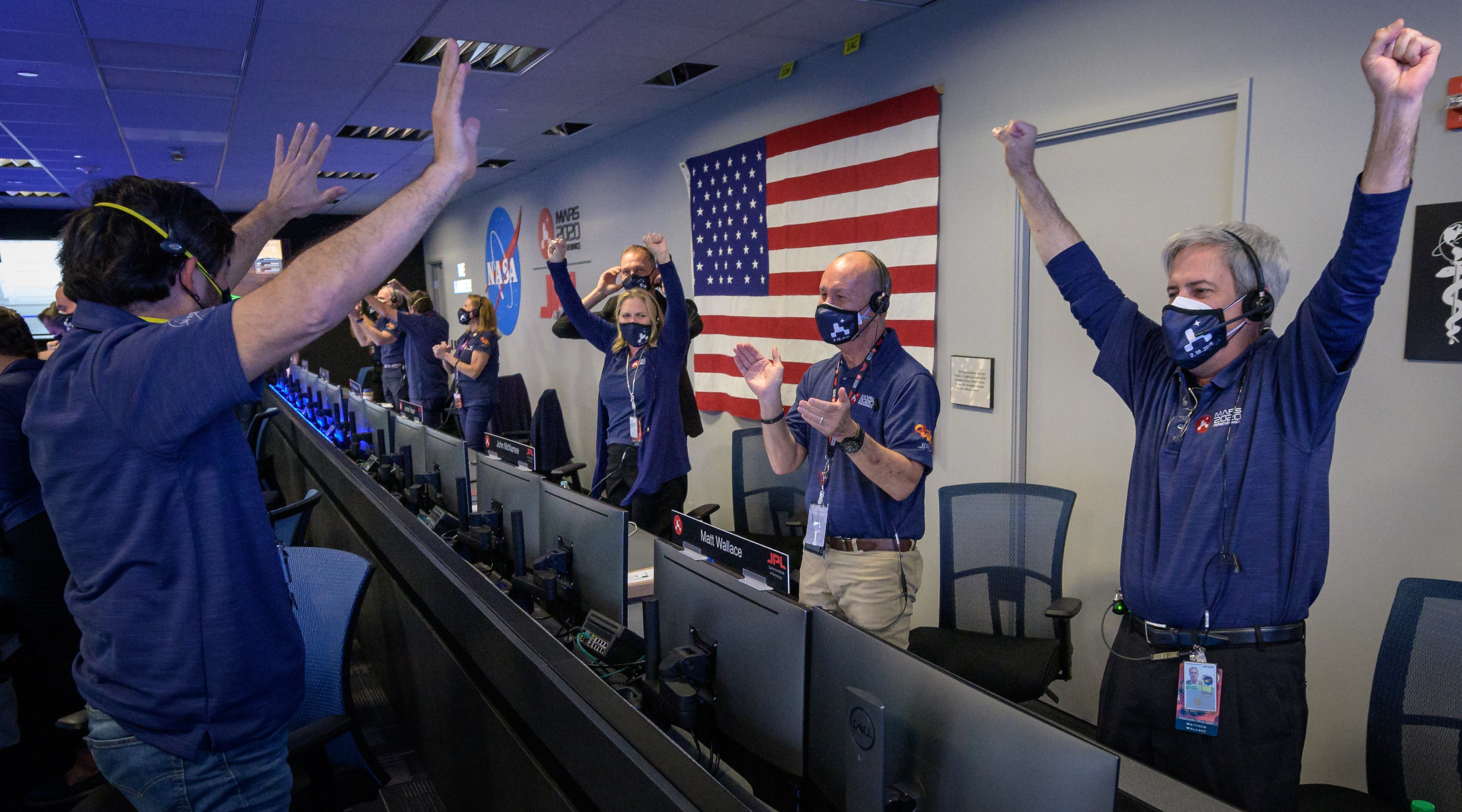
U.S. President Joe Biden and Vice President Kamala Harris are lauding the successful Mars landing by NASA’s Perseverance rover. Biden called acting NASA chief Steve Jurzyck an hour after the landing to send his regards. Read our full story on it here.
In separate tweets, Biden and Harris congratulated the Perseverance rover team. Former President Barack Obama also weighed in, congratulating the team on a successful mission. The Perseverance rover, formerly known as Mars 2020, was first announced in December 2012 during Obama’s first term as president.
Congratulations to NASA and everyone whose hard work made Perseverance’s historic landing possible. Today proved once again that with the power of science and American ingenuity, nothing is beyond the realm of possibility. pic.twitter.com/NzSxW6nw4kFebruary 18, 2021
Post-landing update coming soon from NASA
Pasadena, Calif. — PERSEVERANCE LANDED! Here at JPL, scientists, engineers, administrators and members of the media (like me) are cheering and celebrating. It’s almost unbelievable that it’s real, it’s so exciting to see the joy here at JPL, the Mars2020 team could not be more thrilled about how today went and where this mission is headed.
NASA will hold a press conference at 5:30 p.m. EST (2230 GMT) to discuss how the landing went. You can watch it live here on Space.com, courtesy of NASA TV.
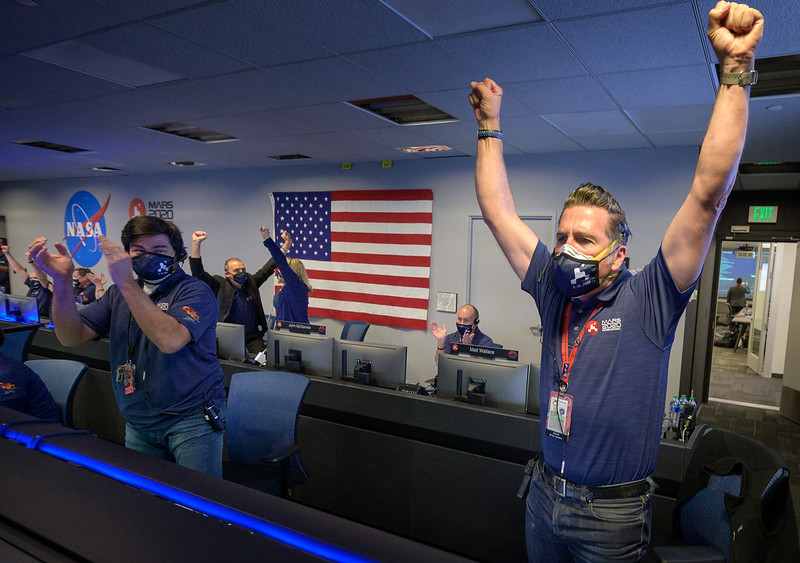
Percy shares its 1st photo from Mars
Here are the first images NASA’s Perseverance rover beamed back to Earth after its successful landing today!

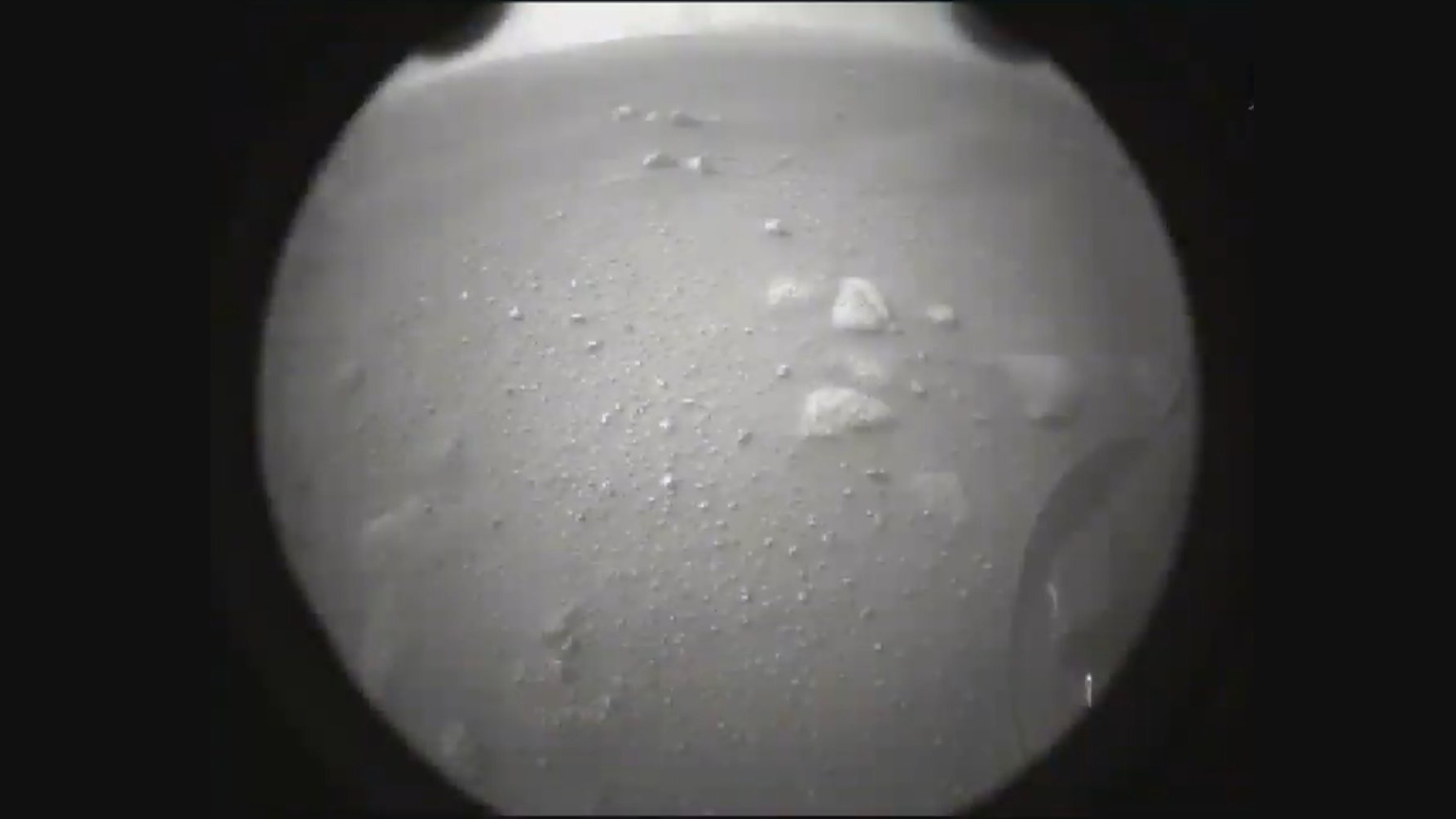
You can watch the JPL team see this photo for the first time in this video clip from NASA TV’s live broadcast of today’s landing.
Touchdown!
NASA has received confirmation that its Perseverance rover has touched down in Jezero Crater!
“We just heard the news that Perseverance is alive on the surface of Mars,” a NASA spokesperson said in NASA’s live broadcast.
Read our full story: Touchdown! NASA’s Perseverance rover lands on Mars to begin hunt for signs of ancient life
I’m safe on Mars. Perseverance will get you anywhere. #CountdownToMarsFebruary 18, 2021
The “7 minutes of terror” start NOW!
The hardware that got me to Mars has done its job, so it’s bye-bye to the cruise stage. #CountdownToMars pic.twitter.com/CXcxm1GHzjFebruary 18, 2021
The Perseverance rover hit the top of the Martian atmosphere at 3:48 p.m. EST (2048 GMT), marking the beginning of the entry, descent and landing sequence, which NASA calls the “seven minutes of terror.” The rover is expected to touch down in Jezero Crater at around 3:55 p.m. EST (2055 GMT).
But keep in mind: These are the times that mission controllers in NASA’s Jet Propulsion Laboratory will receive signals from Mars confirming that these events have taken place. Because the radio transmissions travel at the speed of light and communications are not instantaneous, it takes about 11 minutes and 22 seconds for a signal to travel from Mars to Earth. This means that the “seven minutes of terror” actually started at 3:37 p.m. EST (2037 GMT).
“The team of engineers that piloted NASA’s Mars 2020 spacecraft, with the Perseverance rover and NASA’s Ingenuity Mars Helicopter inside, during the cruise from Earth to the Red Planet has handed over the reins to the entry, descent, and landing (EDL) team,” NASA officials said in an update.
Next stop: MARS!
The landing is looking good from NASA JPL
Pasadena, Calif. — Space.com senior writer Chelsea Gohd here reporting LIVE from NASA’s Jet Propulsion Laboratory, where the agency’s Mars 2020 team is hard at work getting its Perseverance rover down to the Red Planet’s surface.
All around me are scientists, engineers and other NASA personnel who have been bustling around campus all morning, masked up and socially distanced for safety during the ongoing coronavirus pandemic. I spoke with a few of them, including Thomas Zurbuchen, associate administrator of NASA’s Science Mission Directorate, who shared how proud he is of the teams that made today’s landing possible despite the challenges that the pandemic threw their way.
The excitement in the air is palpable and I even saw a few people walking into buildings toting boxes of Krispy Kreme doughnuts (containing what I can only assume are the new Mars-themed treats the company rolled out just for today’s landing).
I am holding my breath as we have just about an hour until the rover lands in Jezero Crater on the Martian surface. Keeping my fingers crossed and eagerly anticipating celebrating a successful landing.
Perseverance rover ready to land on Mars
NASA’s live webcast for today’s Perseverance Mars rover is under way. You can watch it live above.
Perseverance’s flight controllers have switched off the rover’s transmitter, leaving it on its own for today’s landing. From here on out, Perseverance will be flying by its onboard computer.
It’s next stop: Jezero Crater.
NASA science chief talks Mars landing
NASA’s Perseverance rover is just hours away from landing on Mars and Space.com’s Chelsea Gohd caught up with the Thomas Zurbuchen, NASA’s Associate Administrator for science missions, to find out how the mission team is feeling.
It’s safe to say the team is excited, and maybe a bit anxious.
Once Perseverance lands on Mars, the engineers and scientists running the mission will have to work on “Mars time” for a while. That means they’ll have to work, live and sleep on the daily schedule on Mars, which has a longer day than the Earth. Here’s how life on “Mars Time” works for NASA.
If you have 23 minutes to spare, check out this NASA documentary on Perseverance for a primer on how the mission will change our understanding of the Red Planet.
Perseverance rover closing in on Mars
As NASA’s Perseverance Mars rover closes in on the Red Planet, Space.com senior writer Chelsea Gohd is at the space agency’s Jet Propulsion Laboratory covering the rover’s arrival. Earlier today, she caught up with planetary scientist Bethany Ehlman to talk about the big science behind the mission. Check it out above.
Visit our Facebook page here at 11:45 a.m. EST (1645 GMT) for Chelsea’s interview with Thomas Zurbuchen, NASA’s associate administrator of science missions, on the importance of today’s landing.
Want to talk about the landing? Join the conversation in our forums here to cheer on Perseverance and let us know what you hope it will find.
Mars is currently 127 million miles from Earth as Perseverance approaches. You can actually see Mars near the moon tonight to celebrate the Mars rover landing. Here’s a guide on how to see Mars tonight!
Have you ever wondered why we keep going to Mars? So did we. Our contributing writer Elizabeth Howell takes a look at humanity’s Mars mission history here.
Perseverance is landing at Jezero Crater on Mars, but you might be surprised on how to actually pronounce the place’s name. Here’s the correct pronunciation here.
Finally, Chelsea did catch up with Mars 2020 systems engineer Chloe Sackier to get an idea of the intricate engineering behind Perseverance’s mission. Watch that interview here and below!
We’ll see you back here at 12 p.m. EST (1700 GMT) with our next update!
It’s landing day on Mars!
Today’s the day: NASA’s Perseverance rover is going to land on Mars.
After a months-long journey, Perseverance will land in the vast Jezero Crater to seek out signs of ancient life (if it exists), collect samples of Mars for a later mission and land the first helicopter on another world. The landing time is set for 3:55 p.m. EST (2055 GMT) and you can watch it live here at 2:15 p.m. EST (1915 GMT), courtesy of NASA TV. Here’s our webcast guide for today’s landing.
Space.com has a series of guides for today’s landing.
Here’s a step-by-step rundown of how Perseverance will land on Mars.
Our senior writer Chelsea Gohd takes a look at the Ingenuity helicopter on Perseverance here.
The weather on Mars for today’s landing is great, senior writer Meghan Bartels reports.
Here’s a guide on how to share the rover landing with your kids.
Wondering about Jezero Crater? Here’s what we know of the region and you can see a photo tour here.
Less than 24 hours til touchdown!
In less than 24 hours, NASA’s latest rover, named Perseverance, will land on the Red Planet as part of the agency’s Mars 2020 mission.
The rover will touch down at 3:55 p.m. EST (2055 GMT) on Feb. 18, if everything goes according to plan.
Perseverance, nicknamed “Percy,” is an ambitious rover, slightly bigger and heavier than the Curiosity rover, with an impressive suite of instruments and experiments. With its tools, “Percy” will cache samples to be returned by a future mission as part of the first-ever Mars sample return mission. It will also search for signs of ancient life on the planet, which is why scientists decided to land the craft in Jezero Crater, which once held an ancient lake and delta, where they think life could have existed billions of years ago.
“Percy” will also deploy Ingenuity, a Mars helicopter stored in its belly, which is set to make the first powered flight on another world, an “extraterrestrial Wright brothers moment,” Thomas Zurbuchen, NASA associate administrator for science at NASA Headquarters, said during the news conference Feb. 16.
You can follow the action in (almost) real-time as NASA will provide coverage of the event beginning at 2:15 p.m. EST (1715 GMT) Feb. 18. You can watch it live here at Space.com, courtesy of NASA, or directly at NASA TV.
Read More: NASA’s Mars rover Perseverance landing: Everything you need to know
2 days until Percy lands!
We are now less than two days away from the epic Mars landing of NASA’s Perseverance rover. The rover is expected to touch down in Jezero Crater on Thursday (Feb. 18) at approximately 3:55 p.m. EST (2055 GMT).
You can watch live coverage of the Perseverance rover’s landing live here on Space.com, courtesy of NASA TV. NASA’s live landing broadcast on Thursday begins at 2:15 p.m. EST (1915 GMT).
To find out more about how the landing will work, check out our step-by-step guide to Perseverance’s landing, and be sure to watch this new video depicting the “7 minutes of terror.”
Perseverance closes in on Mars
Perseverance’s journey through interplanetary space is nearly over. The rover is now just three weeks away from its long-awaited touchdown on the floor of Mars’ Jezero Crater.
NASA is riding an impressive streak of successful Mars landings (knock on wood), but you can’t take Perseverance’s touchdown for granted.
“Success is never assured,” Allen Chen of NASA’s Jet Propulsion Laboratory in Southern California, the entry, descent, and landing lead for Perseverance’s mission, said on Wednesday (Jan. 27). “And that’s especially true when we’re trying to land the biggest, heaviest and most complicated rover we’ve ever built in the most dangerous site we’ve ever attempted to land in.”
Perseverance rover is halfway to Mars
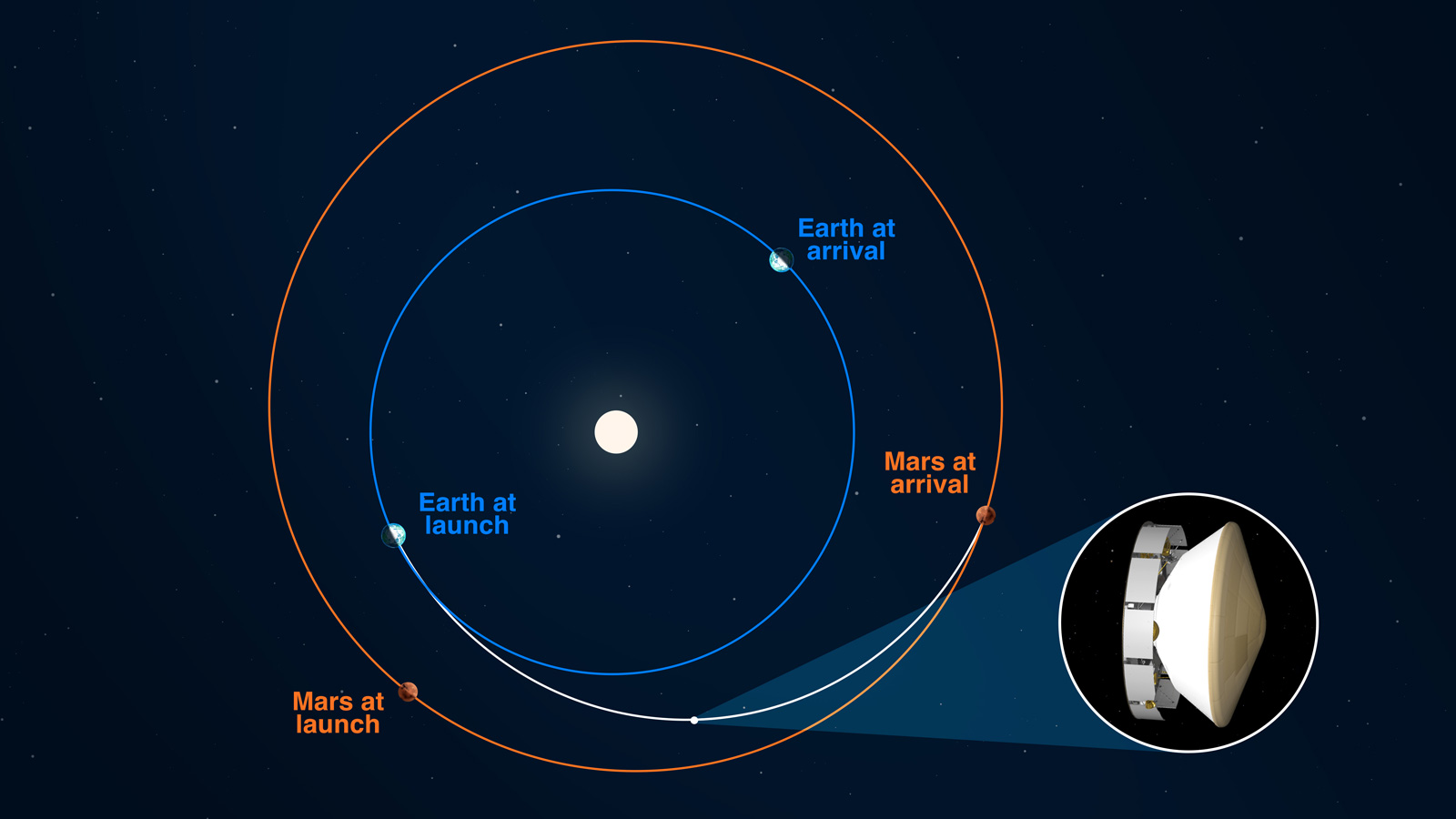
NASA’s Mars rover Perseverance has passed the halfway mark on its road to the Red Planet.
The rover, which launched July 30, passed the midpoint of its Martian voyage on Oct. 27 after traveling about 146 million miles (235 million kilometers). Perseverance is scheduled to reach Mars on Feb. 18, where it will land on in a region called Jezero Crater.
You can read our full report on Perseverance’s midpoint to Mars here.
Follow Perseverance to Mars
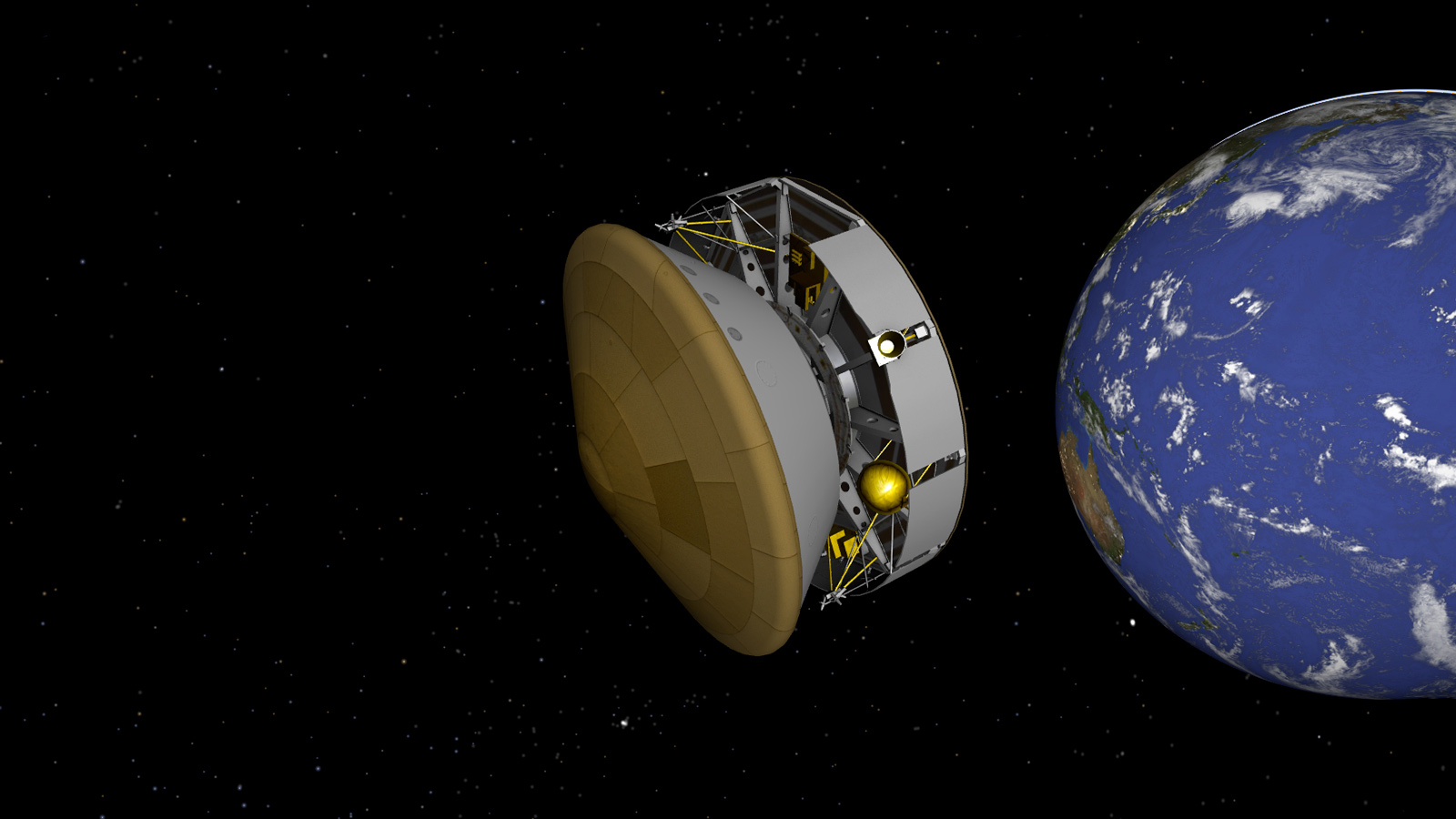
After blasting off on July 30, NASA’s Mars 2020 Perseverance rover is on its way to Jezero Crater on the Red Planet where it’s scheduled to land Feb. 18, 2021. Now, thanks to a new, interactive NASA web application called Eyes on the Solar System, you can follow the industrious spacecraft on its interplanetary journey.
“Eyes on the Solar System visualizes the same trajectory data that the navigation team uses to plot Perseverance’s course to Mars,” Fernando Abilleira, the Mars 2020 mission design and navigation manager at NASA’s Jet Propulsion Laboratory (JPL) in Southern California, said in a statement. “If you want to follow along with us on our journey, that’s the place to be.”
You can check out the app here and follow “Percy” on its incredible voyage.
Rover-naming teens are “over the moon”
July 30, NASA’s Mars 2020 Perseverance rover successfully lifted off from Earth, bound for the Red Planet, where it is set to land Feb. 18, 2021. Of the many people excited to see the rover lift off, two teenagers watching the launch in Florida had a special connection. These two teens actually named the rover and its onboard helicopter.
Alex Mather, a 7th-grade student from Virginia, and Vaneeza Rupani, a high-school senior from Alabama, named the Perseverance rover and the helicopter Ingenuity, respectively.
Learn more about the teens and their work here.
One of the best parts of watching @NASAPersevere launch to Mars was sharing this moment with Alex Mather and Vaneeza Rupani. More about these incredible students: https://t.co/4OoA83hHDp pic.twitter.com/2aAP9IsdBbAugust 6, 2020
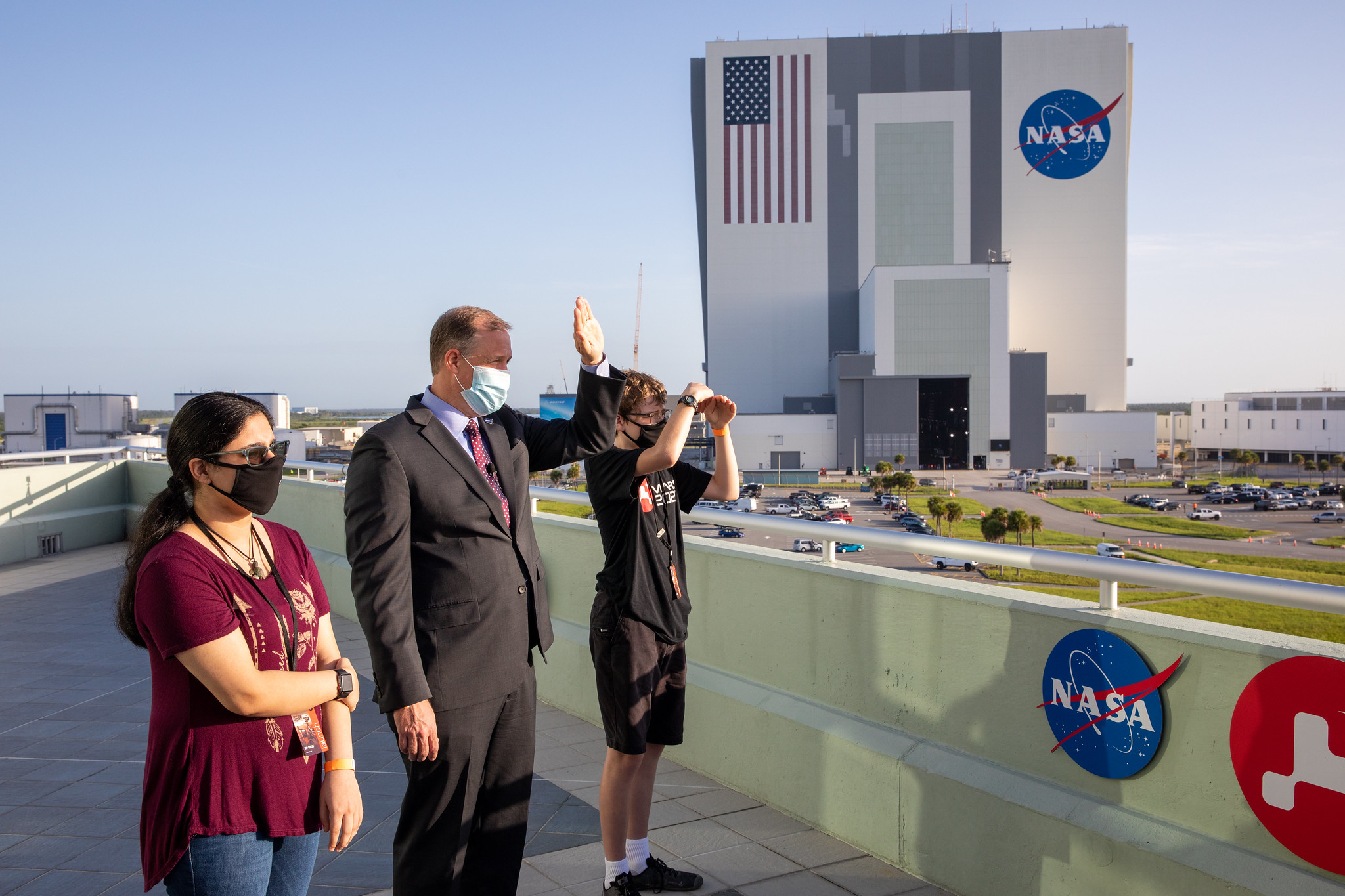
Spotting Percy en route to Mars
Since NASA’s Mars 2020 Perseverance rover launched to the Red Planet July 30, both a weather satellite and a robotic telescope have spotted the craft on its way to its dusty destination.
The weather satellite GOES-16 spotted the smoke plume coming from the Florida launch and The Virtual Telescope Project spied the booster from the Atlas V rocket which launched the rover-holding spacecraft.
Learn more about the Percy sighting here.

Mars rover Perseverance out of ‘safe mode’
NASA’s Mars rover Perseverance, which went into a protective “safe mode” shortly after its launch yesterday, is back to normal operations and cruising toward the Red Planet.
In an announcement today, July 31, NASA officials reported that Perseverance is healthy and out of “safe mode” following a temperature variance that prompted the rover’s onboard computer to enter the protective state. The spacecraft got a bit colder than expected when it zoomed through Earth’s shadow.
“With safe mode exit, the team is getting down to the business of interplanetary cruise,” Mars 2020 deputy project manager Matt Wallace, of NASA’s Jet Propulsion Laboratory in Pasadena, California, said in an update. “Next stop, Jezero Crater.”
You can read our full story here.
Here is full explanation of the issue by Wallace in a previous NASA update on July 30:
“First, the proximity of the spacecraft to Earth immediately after launch was saturating the ground station receivers of NASA’s Deep Space Network. This is a known issue that we have encountered on other planetary missions, including during the launch of NASA’s Curiosity rover in 2011. The Perseverance team worked through prepared mitigation strategies that included detuning the receivers and pointing the antennas slightly off-target from the spacecraft to bring the signal within an acceptable range. We are now in lock on telemetry after taking these actions.
“The second issue was a transient event involving temperature on the spacecraft. The mission uses a liquid freon loop to bring heat from the center of the spacecraft to radiators on the cruise stage (the part that helps fly the rover to Mars), which have a view to space. We monitor the difference in temperature between the warm inlet to the radiators and the cooler outlet from the radiators. As the spacecraft entered into Earth’s shadow, the Sun was temporary blocked by Earth, and the outlet temperature dropped. This caused the difference between the warm inlet and cooler outlet to increase. This transient differential tripped an alarm and caused the spacecraft to transition into the standby mode known as ‘safe mode.’
“Modeling by the team predicted something like this could happen during eclipse – the time when the spacecraft is in Earth’s shadow – but we could not create this exact environment for tests prior to launch. Nor did we have flight data from Curiosity, because its trajectory had no eclipse. We set the limits for the temperature differential conservatively tight for triggering a safe mode. The philosophy is that it is far better to trigger a safe mode event when not required, than miss one that is. Safe mode is a stable and acceptable mode for the spacecraft, and triggering safe mode during this transitional phase is not problematic for Mars 2020.
“With the understanding of the causes of these issues, we are conducting the operations necessary to move the spacecraft back out of safe mode and into normal cruise mode.”
Percy’s first day to Mars
Today (July 31), NASA’s Mars 2020 Perseverance rover begins its first full day in its roughly seven-month trip to the Red Planet. Perseverance, or “Percy,” is now one of three craft traveling to Mars and slated to arrive in February 2021.
The first to launch was the United Arab Emirates’ “Hope” orbiter, the second was China’s Tianwen-1 orbiter/lander/rover combined mission and now, Percy is well on its way to Mars where it will land in an ancient Martian Lake — Jezero Crater.
However, is this a space race to Mars? Not quite — here’s why.
While Hope will orbit Mars and Tianwen-1 will attempt to orbit around, land on the planet and explore, Percy will study Mars in a number of unique ways. One of the things Percy will do that has never been done before is the rover will cache samples of Martian material that will be picked up and transported to Earth with a future mission. Learn all about Percy’s sample-return efforts here.
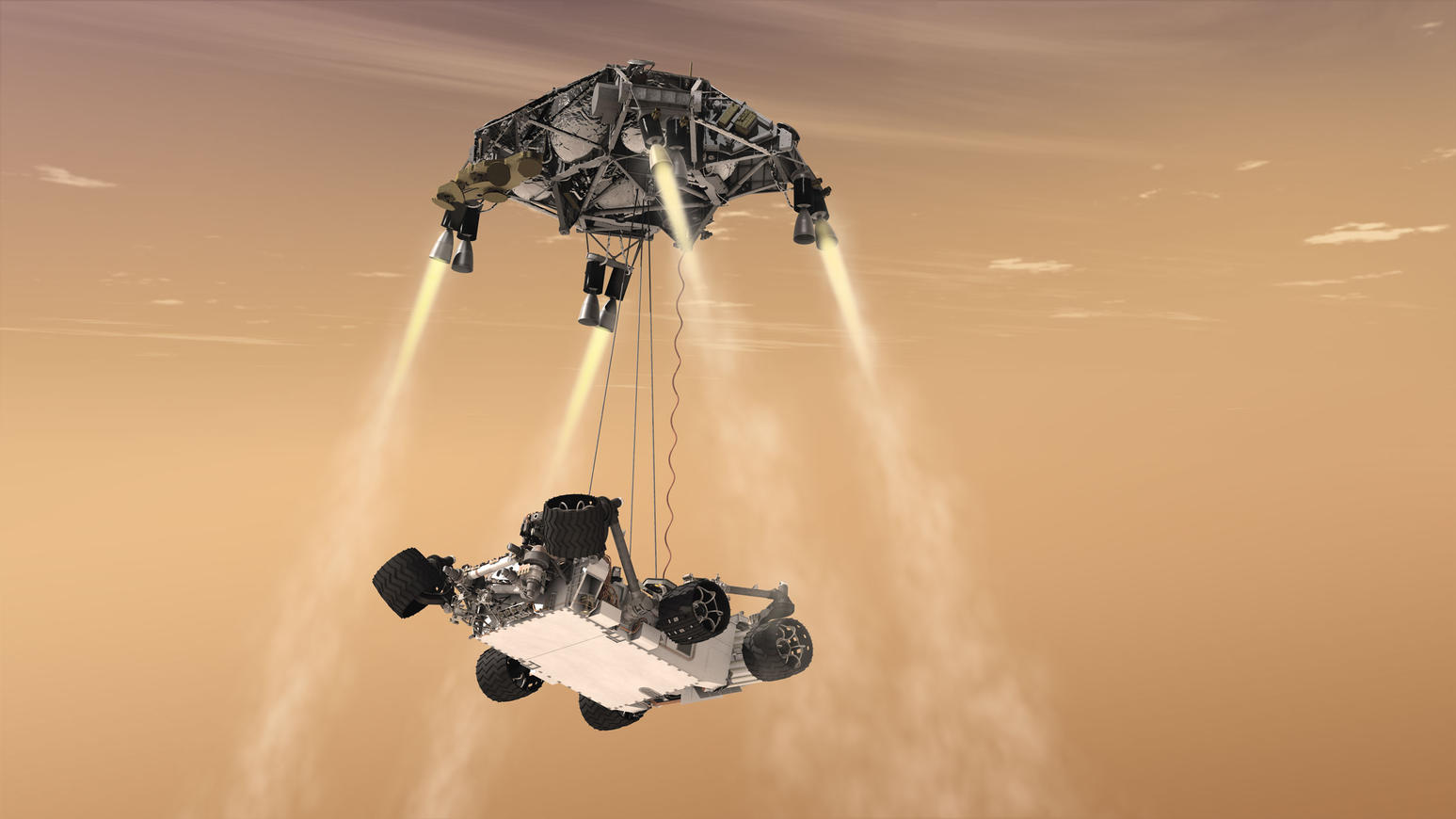
Update on Perseverance rover in Safe Mode
Space.com has new details on the Perseverance Mars rover’s “safe mode” event that occurred shortly after launch.
Matt Wallace, deputy project manager for Mars 2020 with NASA’s Jet Propulsion Laboratory, told Space.com contributor Amy Thompson at the Kennedy Space Center in Cape Canaveral, Florida, that Perseverance’s safe mode condition has been traced to temperature fluctuations in the cooling system for its nuclear battery. Here’s her report:
The rover’s power source is a nuclear powered generator known as an MMRTG. It’s attached to the rover, which is cocooned inside the entry capsule of the vehicle. When the rover is out in the breeze on the Martian surface, it’s fine. However, when it’s in the entry capsule (which will protect Perseverance during entry, descent and landing on Mars), things can get a bit warm.
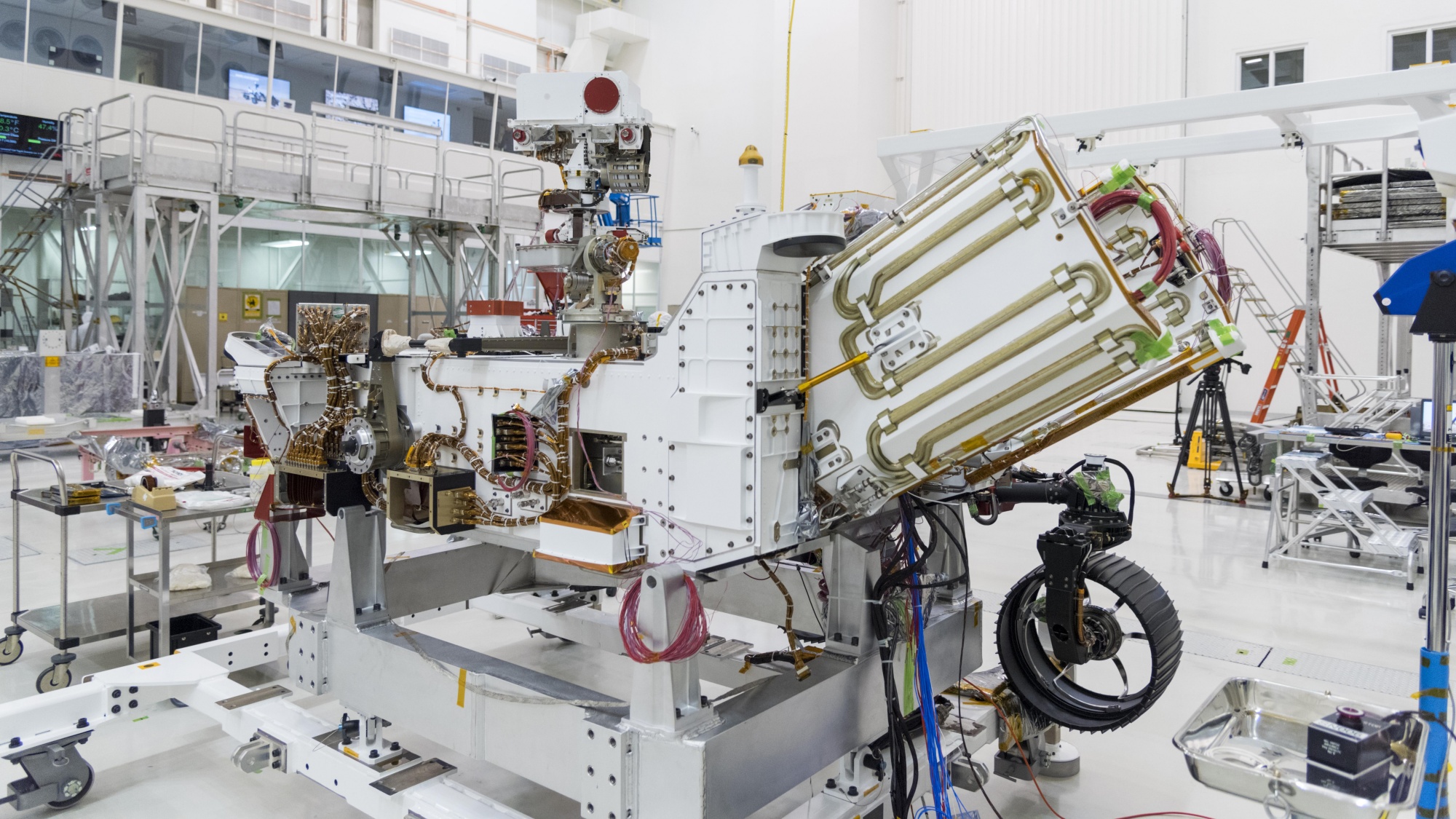
To help mitigate this issue, the vehicle relies on a cooling system that pumps freon from the MMRTG to a set of radiators. While this process is cycling, computers monitor the temperature differences to make sure the rover stays within preset parameters.
As the spacecraft transitioned into its brief eclipse period — a part of its flight when the sun is being blocked by the Earth — that temperature difference increased rapidly, triggering the craft to enter safe mode.
Wallace explained that since engineers cannot duplicate the space environment here on Earth, they estimate what the temperatures should be and set very conservative parameters.
“Unfortunately, our analysis is never really perfect,” he told Space.com. “Curiosity didn’t have an eclipse in its flight trajectory so we didn’t have flight data to know what was going to happen.”
“The spacecraft was never in jeopardy,” he added. “Our philosophy is to be overly conservative on the parameters because we’d much rather trigger a safing event we didn’t need, than miss a safing event we do need.”
The team will continue to analyze the telemetry data that the vehicle has sent so far and double check that this is indeed the hiccup. Once that is complete, the team can put the rover back in an operational status.
Wallace says he expects for the spacecraft to return to normal operations mode tomorrow (July 31). But the team is not in any rush and are taking their time to carefully review all the data. Wallace says there’s plenty of time before the next big phase of the mission.
Perseverance rover in ‘safe mode’ after launch
NASA officials just confirmed that the Mars 2020 Perseverance rover entered a protective “safe mode” after its launch today due to an unexpected temperature condition on the spacecraft.
The rover’s launch was successful, with Perseverance on the right path to Mars. But shortly after liftoff, telemetry indicated the rover entered a “safe mode” due to unexpectedly cold temperatures, NASA officials said.
“Data indicate the spacecraft had entered a state known as safe mode, likely because a part of the spacecraft was a little colder than expected while Mars 2020 was in Earth’s shadow,” NASA officials said in a statement. “All temperatures are now nominal and the spacecraft is out of Earth’s shadow.”
“Safe mode” is a protective state for spacecraft and rovers in which they shut down non-essential systems until receiving new commands from Earth.
“An interplanetary launch is fast-paced and dynamic, so a spacecraft is designed to put itself in safe mode if its onboard computer perceives conditions are not within its preset parameters,” NASA officials wrote in the statement. “Right now, the Mars 2020 mission is completing a full health assessment on the spacecraft and is working to return the spacecraft to a nominal configuration for its journey to Mars.”
Mars rover Perseverance mission in good health
NASA’s Mars rover Perseverance post-launch briefing has ended. The rover is in good shape after launch, even as flight controllers work on a minor communications issue related to the rover’s stronger-than-expected signal strength, NASA officials said.
Read our launch wrap story here!
Thomas Zurbuchen, NASA associate administrator for science missions, said he’s thrilled with the launch.
“I’m relieved. It’s a space mission now,” Zurbuchen said. The communications glitch is something the rover team is working on, but that’s part of the job when it comes to space missions, he added.
Here’s some more amazing launch photos.

Matt Wallace, NASA’s deputy project manager for Perseverance, said Perseverance may have experienced a “temperature transient” event after launch that could have placed its computer in a protective safe mode, but more time is needed to confirm the telemetry. It should take about an hour to wrap that up, he said.
In the meantime, Perseverance has now begun a 6.5-month cruise to Mars. This concludes on launch coverage, but updates will be posted as news on Perseverance is available throughout the mission.
Thanks for joining us!
NASA gets Perseverance rover telemetry
NASA’s post-launch press conference for the Perseverance rover is under way.
Matt Wallace, NASA’s deputy project manager for Perseverance, reports that the Deep Space Network has established a telemetry lock with the rover. As of 11:50 a.m. EDT (1550 GMT), it should take about 30 to 60 minutes to verify the rover’s condition, but all signs point to good health, Wallace said.
Perseverance’s signal is extremely strong, and a bit overwhelming for the Deep Space Network’s sensitive receiver. A similar issue occurred after the Curiosity rover launch in 2011, he said. The signal is being modulated so the DSN can process it, he added.
Signal issues
Shortly after signal acquisition, NASA teams had an issue with matching signal strengths between the spacecraft and ground stations. However, this is seen as a temporary issue and one that is not only easily solvable, but that has been solved before, NASA Administrator Jim Bridenstine shared on Twitter.
“We had a good launch this morning, we’re right on course for Mars and signal from @NASAPersevere is strong. We are working to configure the ground stations to match the strength of the spacecraft signal. This scenario is one we’ve worked through in the past with other missions,” Bridenstine tweeted.
Read our launch wrap details all of the amazing moments from this mission here.
We had a good launch this morning, we’re right on course for Mars and signal from @NASAPersevere is strong. We are working to configure the ground stations to match the strength of the spacecraft signal. This scenario is one we’ve worked through in the past with other missions.July 30, 2020
I am healthy and on my way to Mars, but may be too loud for the antennas on Earth while I’m so close. Ground stations are working to match my signal strength so that I can communicate clearly with my team. https://t.co/vLaRxcKomRJuly 30, 2020
Signal acquisition
Following successful spacecraft separation, NASA has reported that the mission “phoned home.”
The mission has officially made contact with ground controllers back on Earth. These signals were received by ground controllers through a NASA tracking station located in Canberra, Australia.
Read our launch wrap details all of the amazing moments from this mission here.
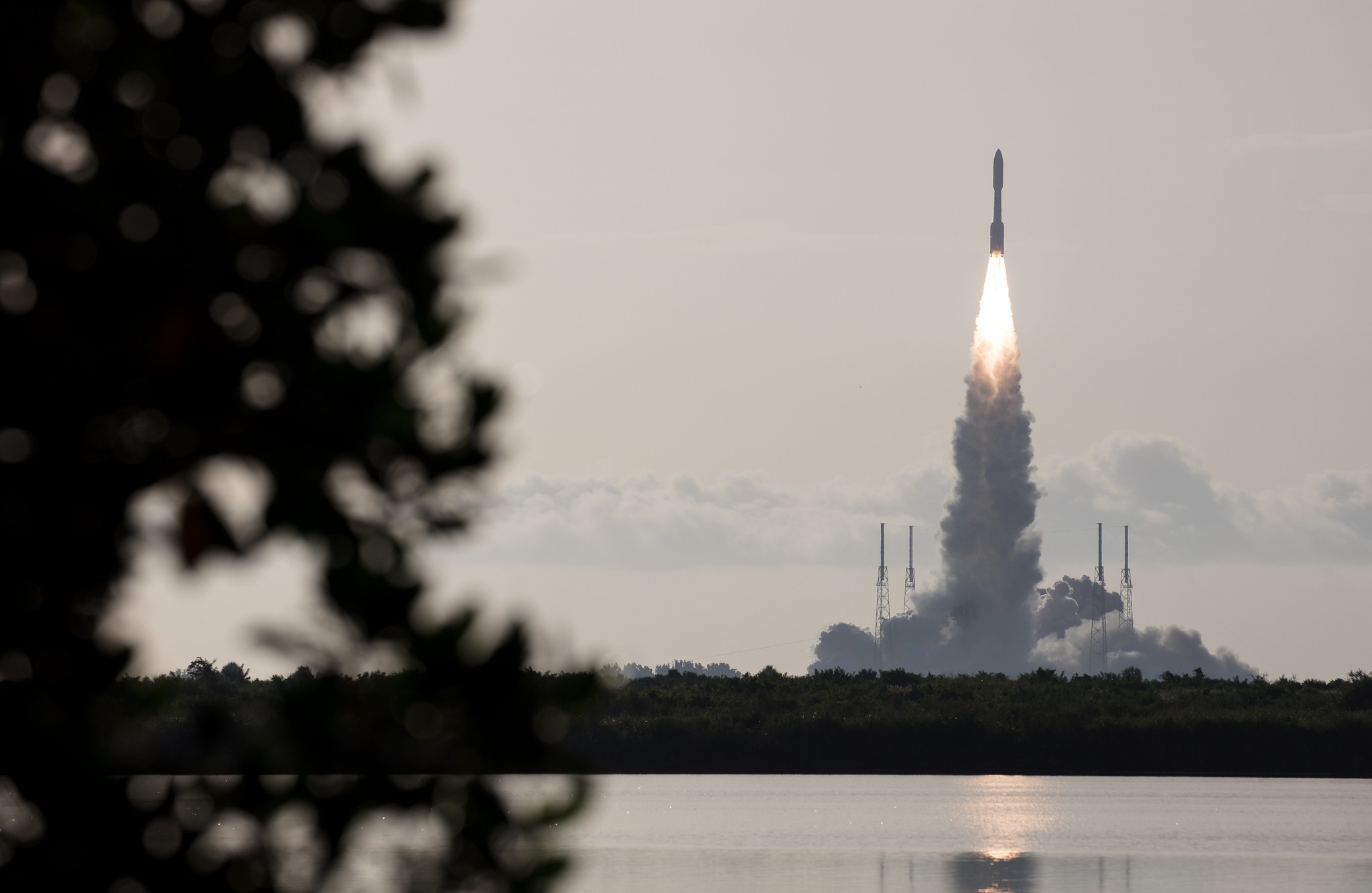
Mars 2020 separation
Huzzah! NASA’s Mars 2020 spacecraft, which contains the agency’s Mars 2020 Perseverance rover, has officially deployed from the Centaur upper stage as scheduled. In about 20 minutes, we can expect the first signals coming from that spacecraft to reach ground controllers on Earth at NASA.
It’s official: NASA’s Mars 2020 Perseverance rover is on its way to Mars.
Read our launch wrap details all of the amazing moments from this mission here.
At 11:30, you can tune back into NASA TV to watch the Mars 2020 Perseverance post-launch news conference.

Escape burn
ULA’s Atlas V rocket has successfully completed an “escape burn,” or its second and final engine firing, as scheduled. This burn is what pushes the vehicle out and towards the Red Planet, where it is set to arrive Feb. 18, 2021, nearly seven months from now.
You can watch the mission unfold live here and on Space.com‘s homepage, courtesy of NASA.
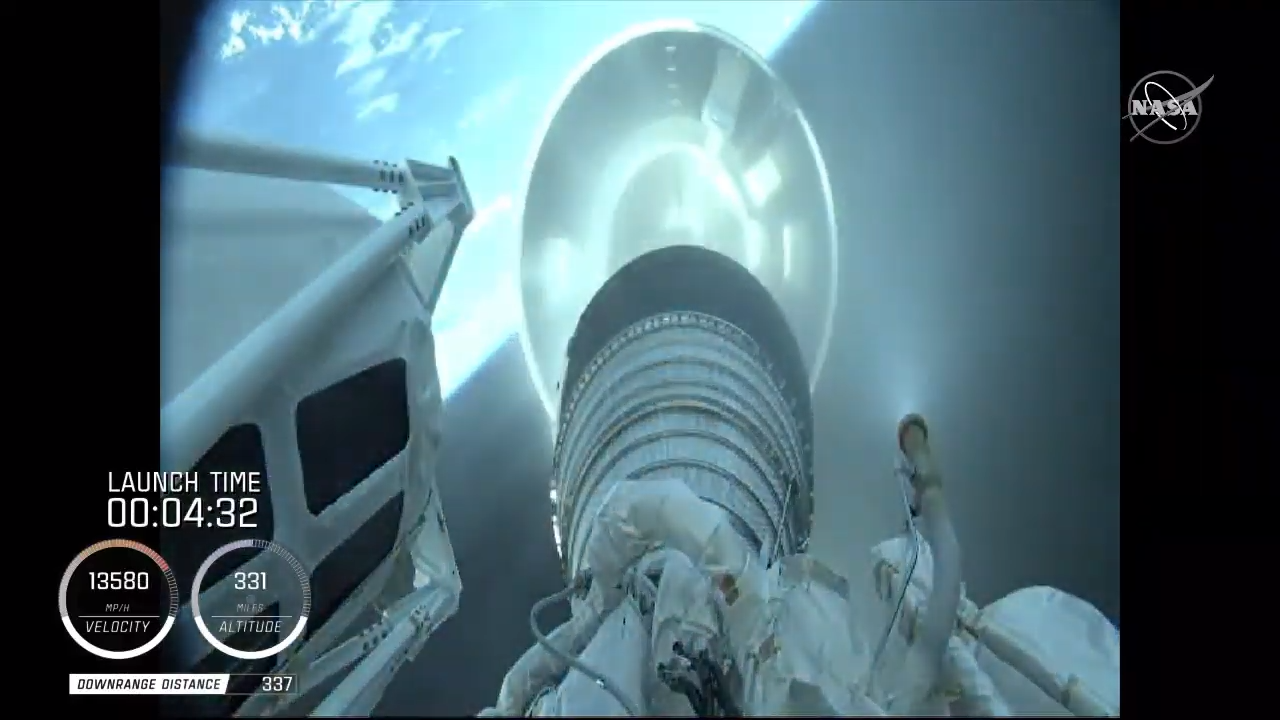
Centaur burn complete
The Atlas V’s first Centaur burn is complete, as scheduled for NASA’s Mars 2020 mission to the Red Planet.
You can watch the mission unfold live here and on Space.com‘s homepage, courtesy of NASA.
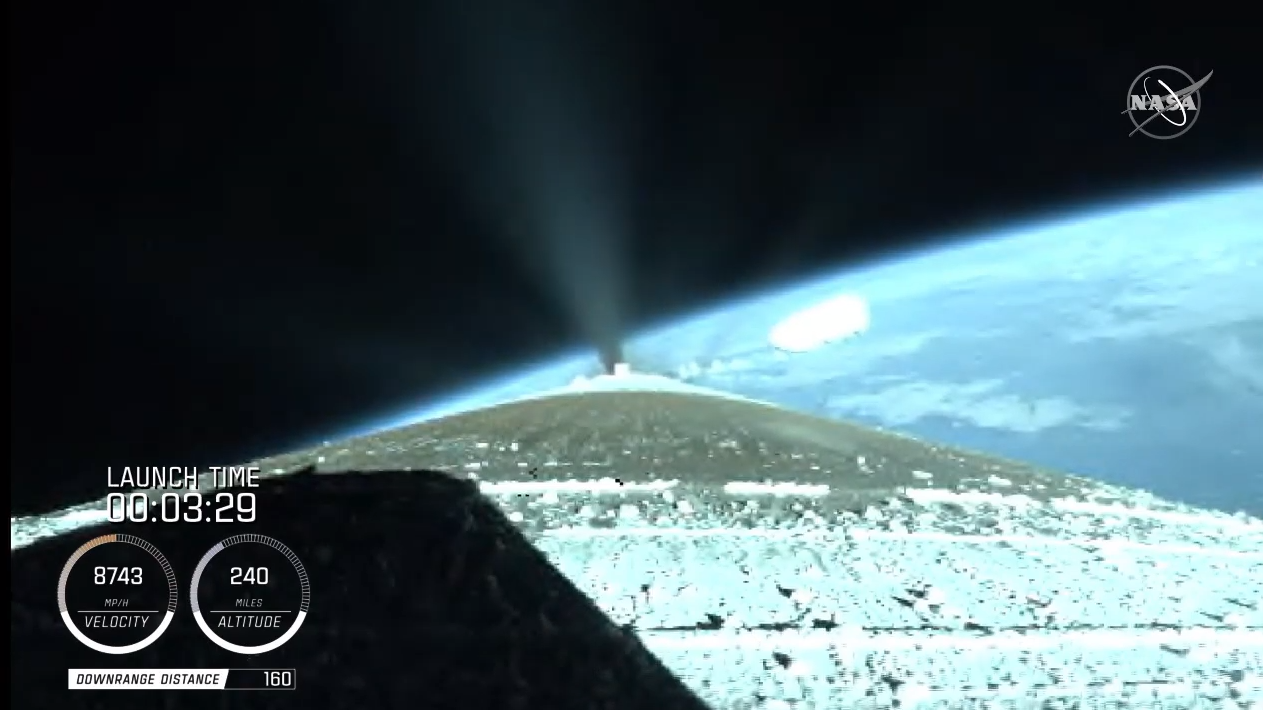
On our way to Mars
NASA’s Mars 2020 Perseverance rover is officially on its way to Mars, with a successful launch earlier this morning atop a United Launch Alliance Atlas V rocket. Check out this sweet photo of the mission making its way in space!
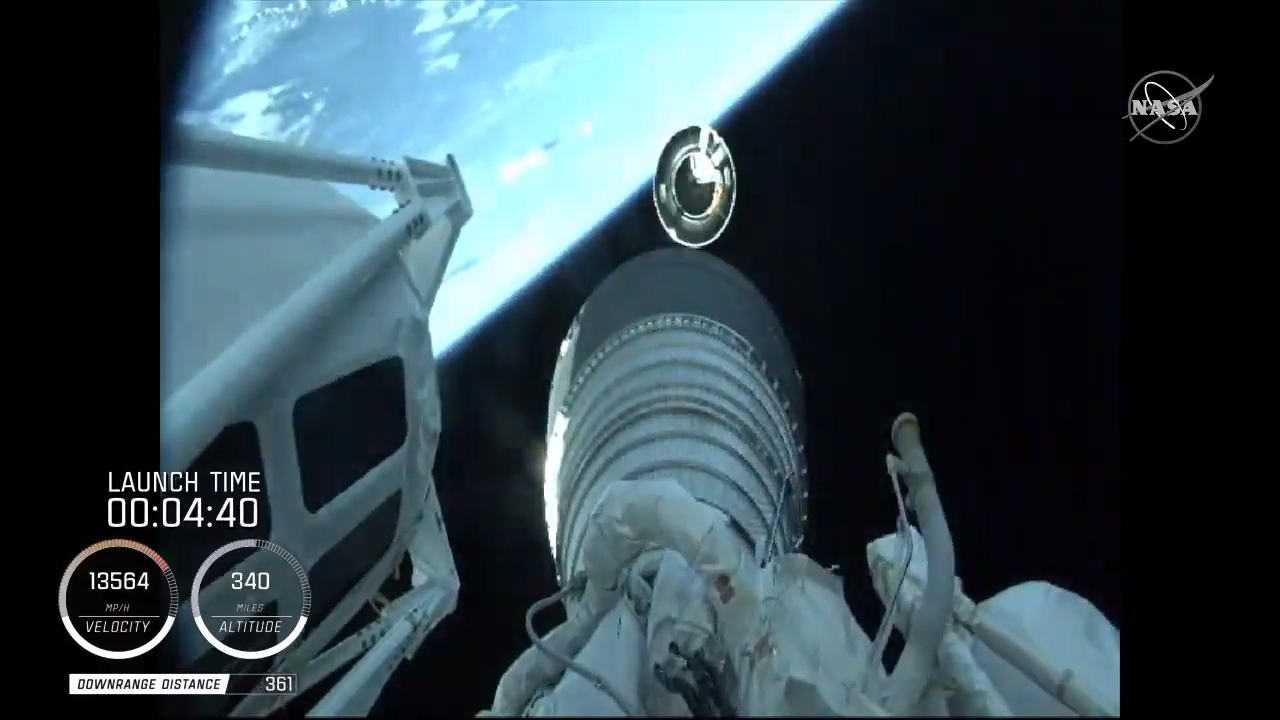
Centaur separation
Atlas V’s Common Core Booster, the first stage of the Atlas 5 rocket separates from Centaur, the upper stage of Atlas V, as scheduled.
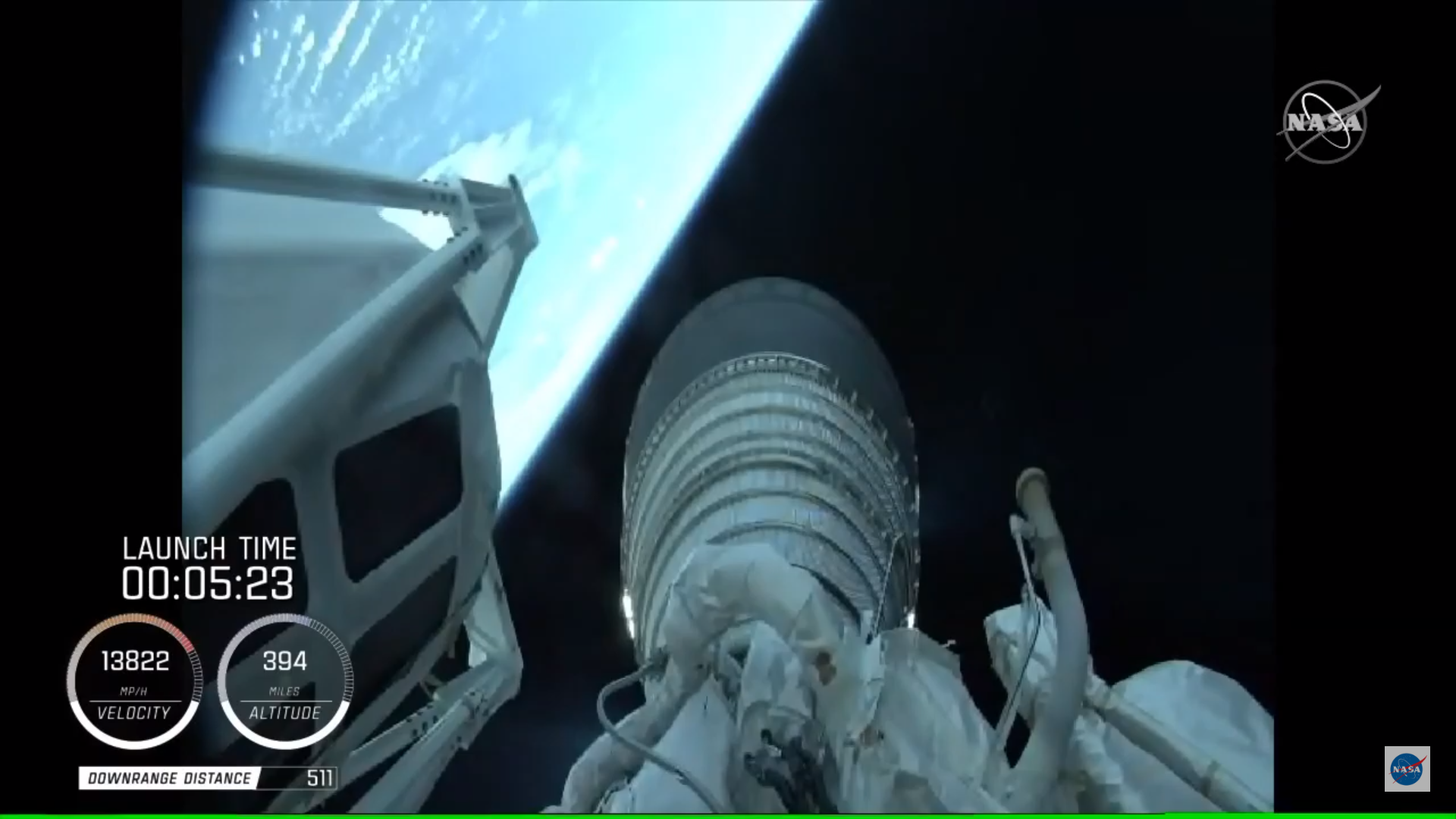
Payload fairing separation
PLF (Payload Fairing Separation): The Atlas V rocket’s payload fairing, or nose cone, which was made in Switzerland by Ruag Space and helped to protect the Atlas V rocket during launch, has separated from the vehicle as scheduled.
SRB separation
SRB (Solid Rocket Booster) jettison: The solid rocket booster helping Atlas V launch the Mars rover Perseverance has separated from the booster as planned.
LAUNCH! Perseverance is on its way to Mars
Go Percy! Go Atlas V! Go Mars 2020! Go Centaur!
NASA’s Mars 2020 Perseverance rover has officially lifted off for Mars from Florida in the United States.
The rover successfully launched aboard a United Launch Alliance Atlas V rocket from Space Launch Complex 41 at Cape Canaveral Air Force Station in Florida. The car-sized rover is officially on its way to Jezero Crater on Mars, where it is set to arrive in about seven months on Feb. 18, 2021.
You can watch the launch live here and on Space.com‘s homepage, courtesy of NASA.
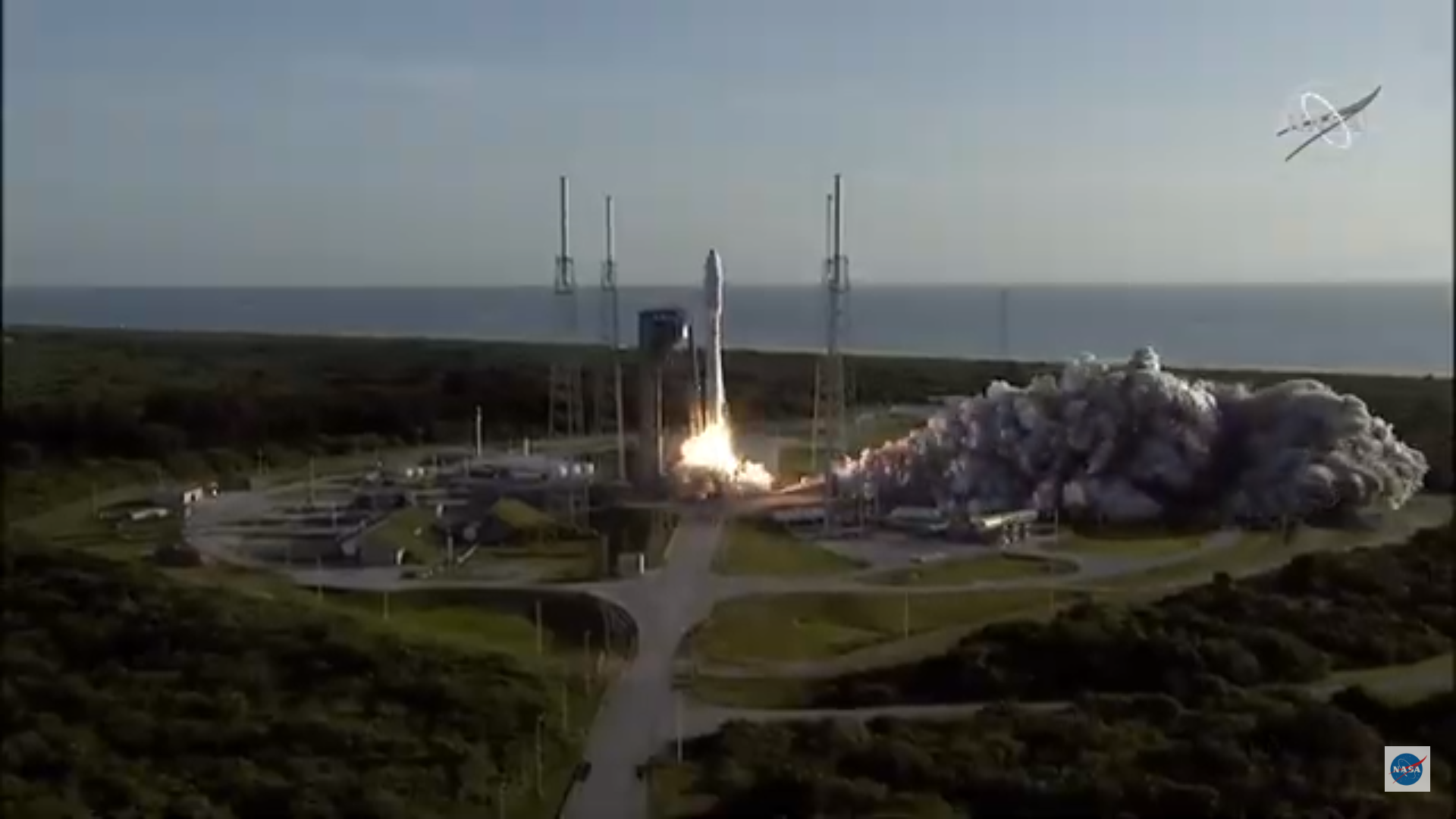
T-minus 10 minutes!
We are 10 minutes from launch! Make sure to tune in to watch history being made.
You can watch the launch live here and on Space.com‘s homepage, courtesy of NASA.
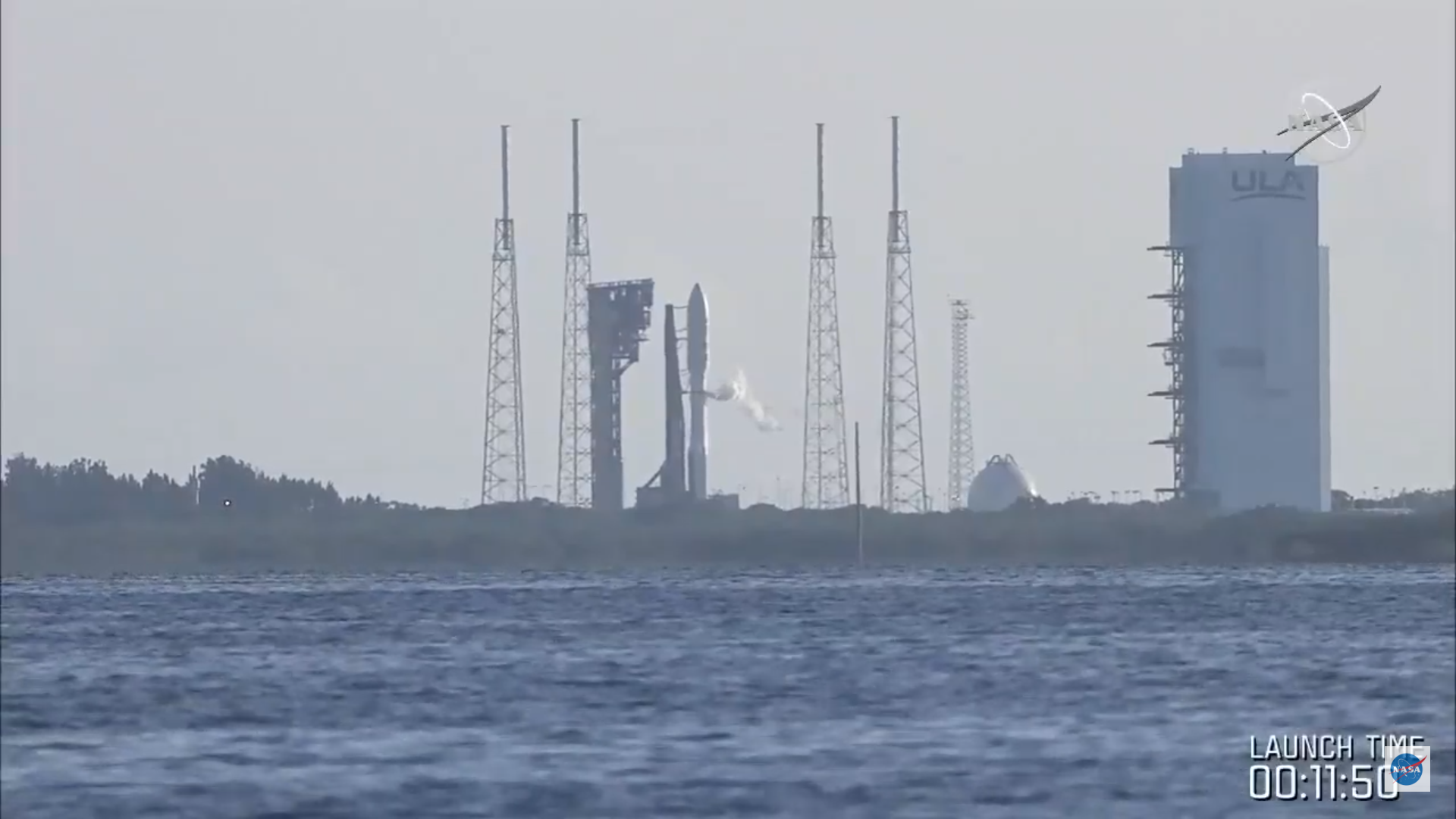
Weather is GO!
The weather in Florida is beautiful and perfect for today’s launch. According to weather officer Jessica Williams, weather is observed and forecast GO for liftoff in just about half an hour.
You can watch the launch live here and on Space.com‘s homepage, courtesy of NASA.
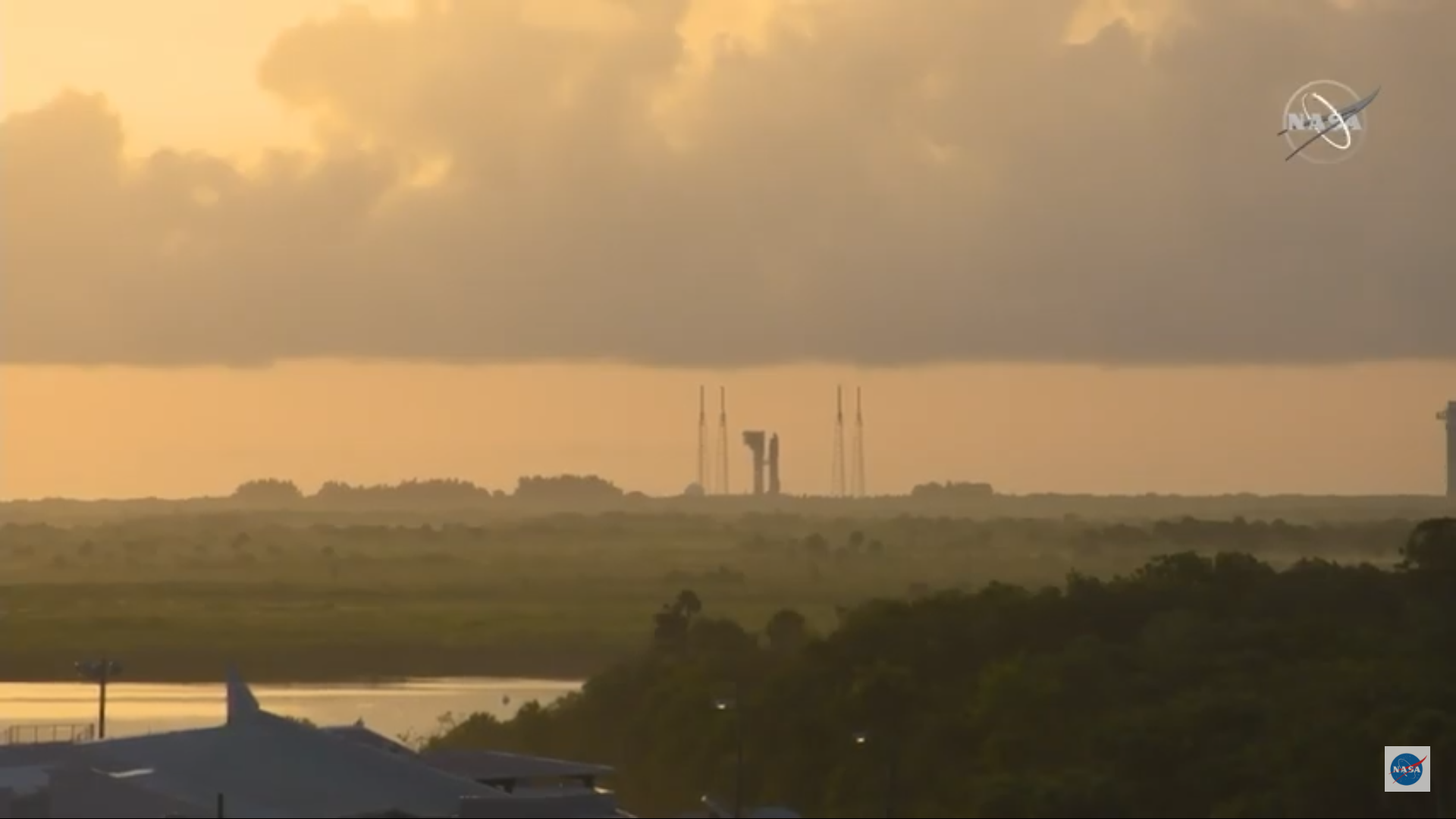
Fully fueled
All tanks on United Launch Alliance’s Atlas V rocket are fully fueled, conditions are nominal and we are still on track for a 7:50 a.m. EDT (1150 GMT) launch.
You can watch the launch live here and on Space.com‘s homepage, courtesy of NASA.
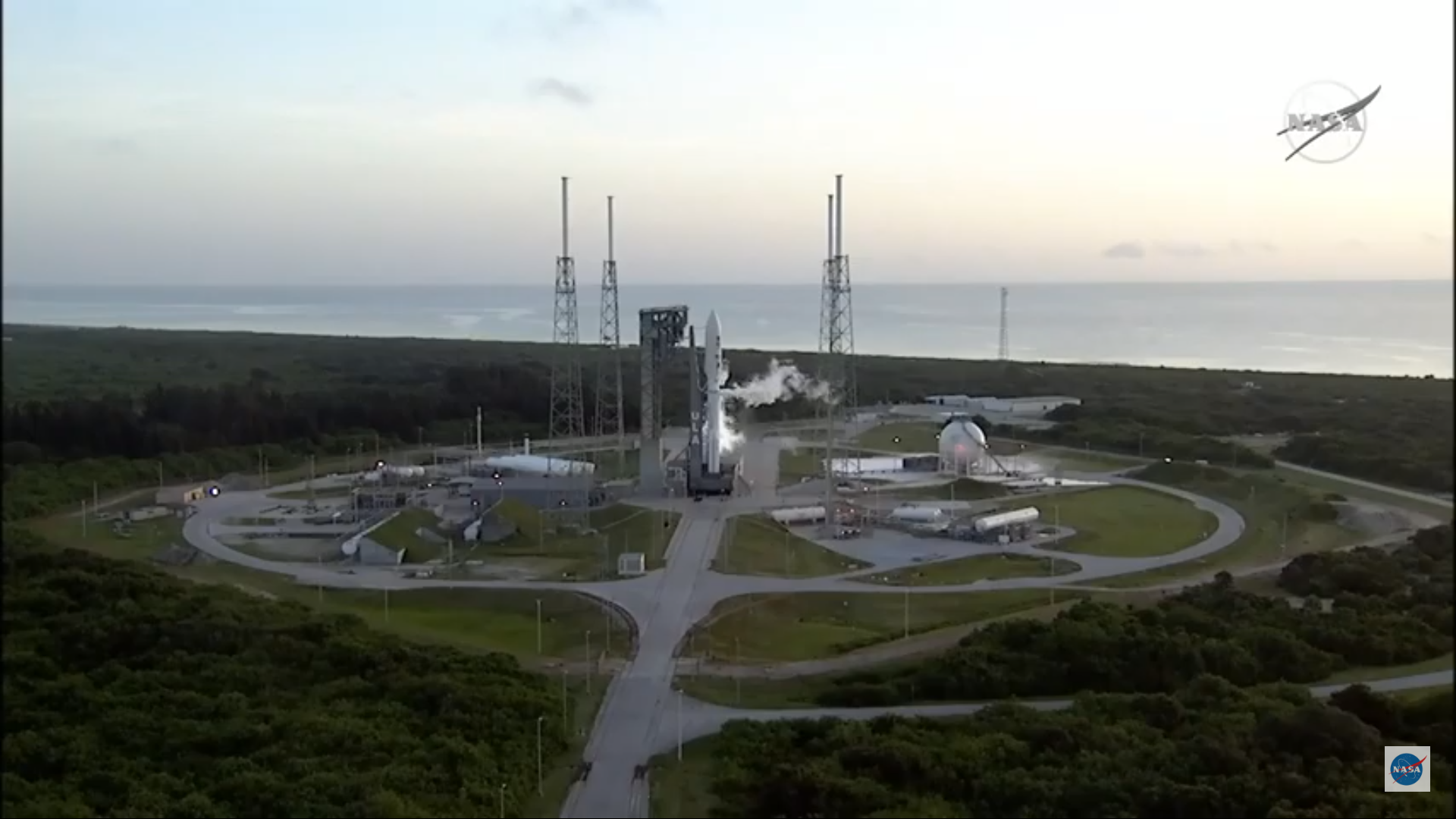
Watch the launch live online – starting NOW!
It is officially 7 a.m. EDT (1100 GMT), which means that you can now follow along with the launch live online. You can watch the launch live here and on Space.com‘s homepage, courtesy of NASA, beginning now (7 a.m. EDT (1100 GMT))!

One hour to go!
We are officially one hour out from today’s launch! The mission is still set to liftoff at 7:50 a.m. EDT (1150 GMT) with NASA’s Mars 2020 Perseverance rover aboard a United Launch Alliance Atlas V rocket.
You can watch the launch live here and on Space.com‘s homepage, courtesy of NASA, beginning at 7 a.m. EDT (1100 GMT).

LOX, or liquid oxygen, loading has been officially completed for United Launch Alliance’s Atlas V rocket’s first stage. The rocket will consume LOX alongside RP-1, a refined kerosene.
The launch is on track and liftoff for the mission remains set for 7:50 a.m. EDT (1150 GMT.)
You can watch the launch live here and on Space.com‘s homepage, courtesy of NASA, beginning at 7 a.m. EDT (1100 GMT).
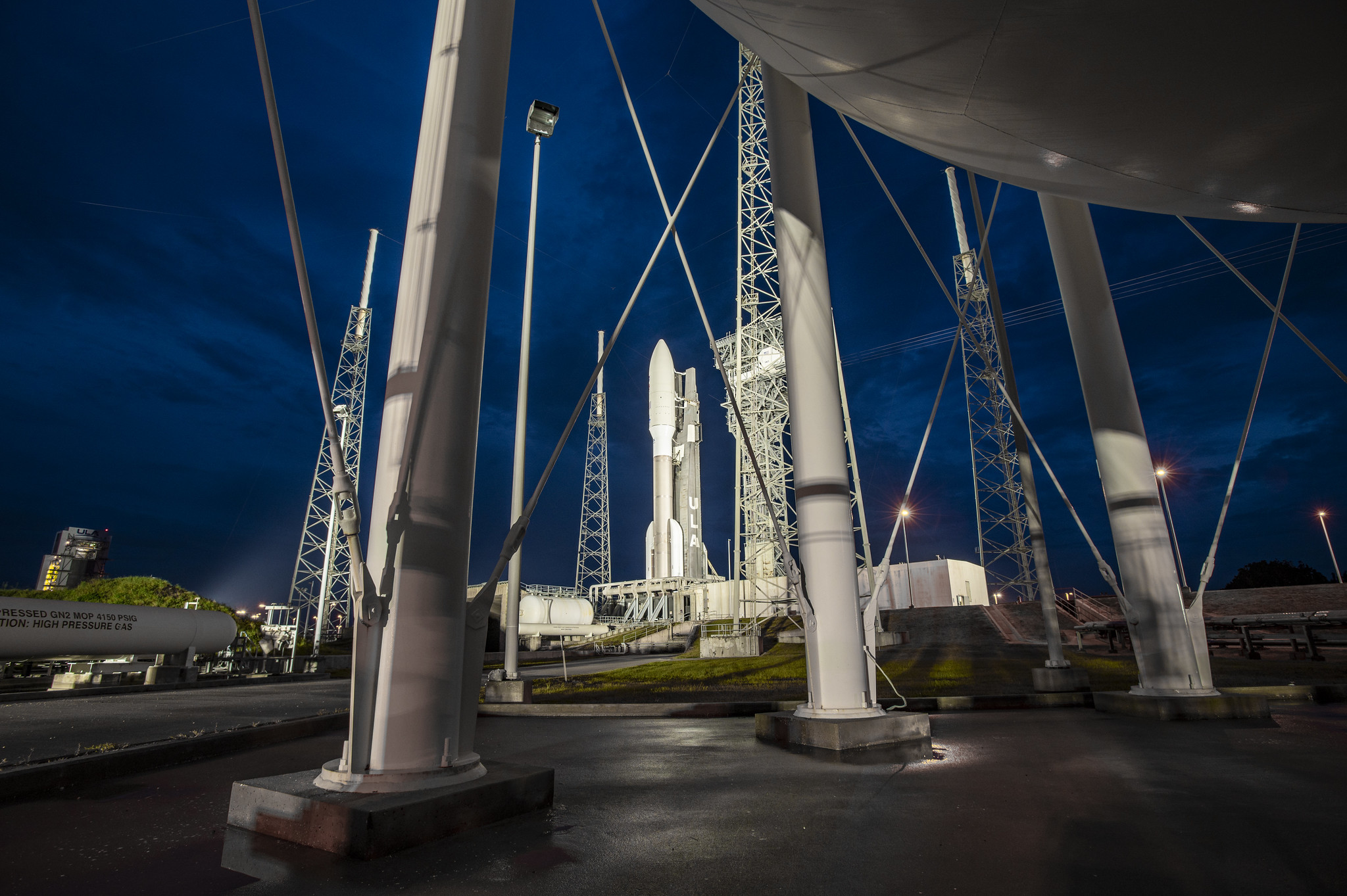
2 hours to launch!
It is officially two hours until NASA’s Mars 2020 Perseverance rover lifts off (at 7:50 a.m. EDT (1150 GMT)) atop a United Launch Alliance Atlas V rocket from Space Launch Complex 41 at Cape Canaveral Air Force Station in Florida.
The weather looks good and “Percy” is poised for Mars!
How to watch live: here.
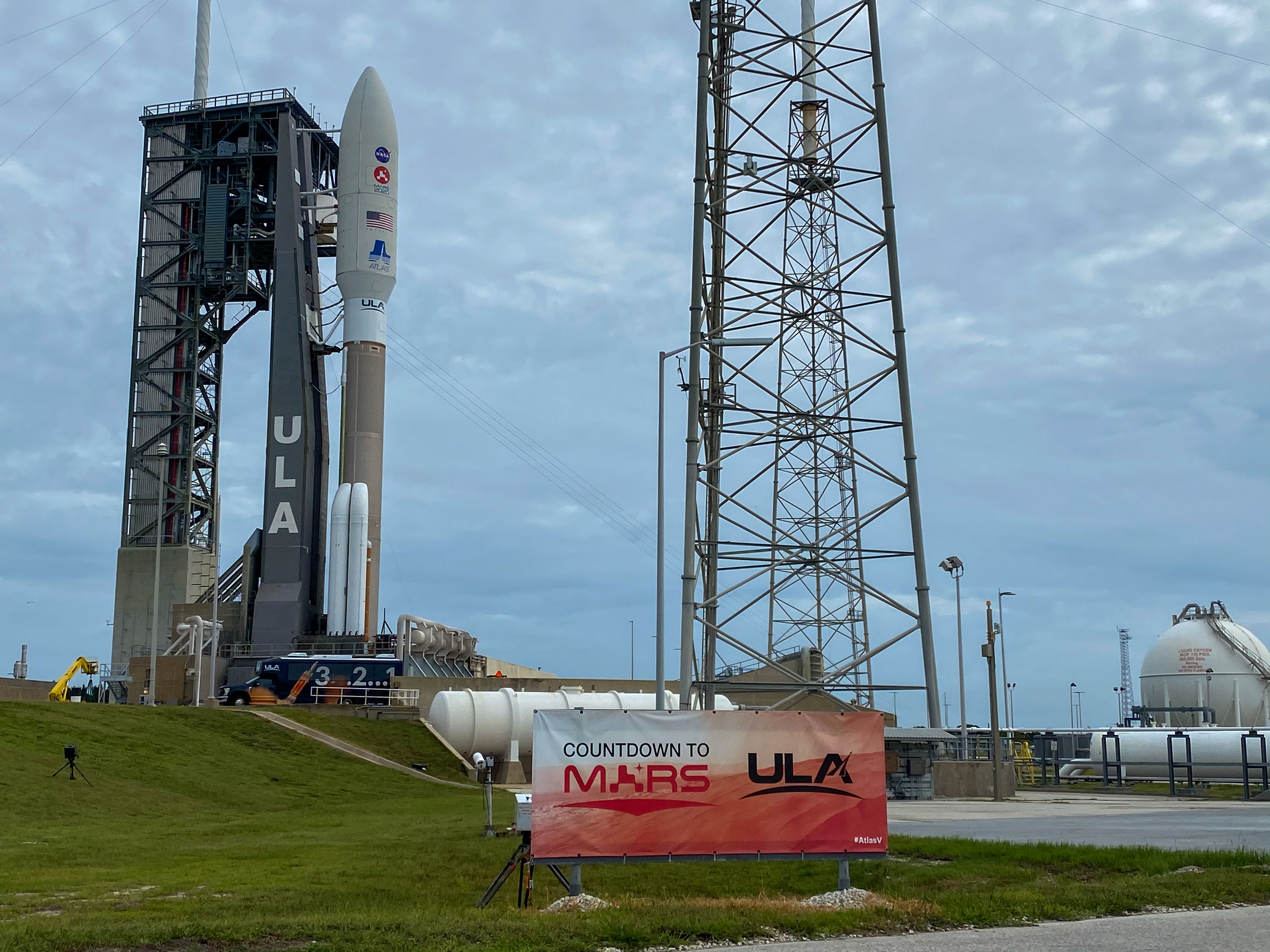
NASA ready for Mars Perseverance rover launch
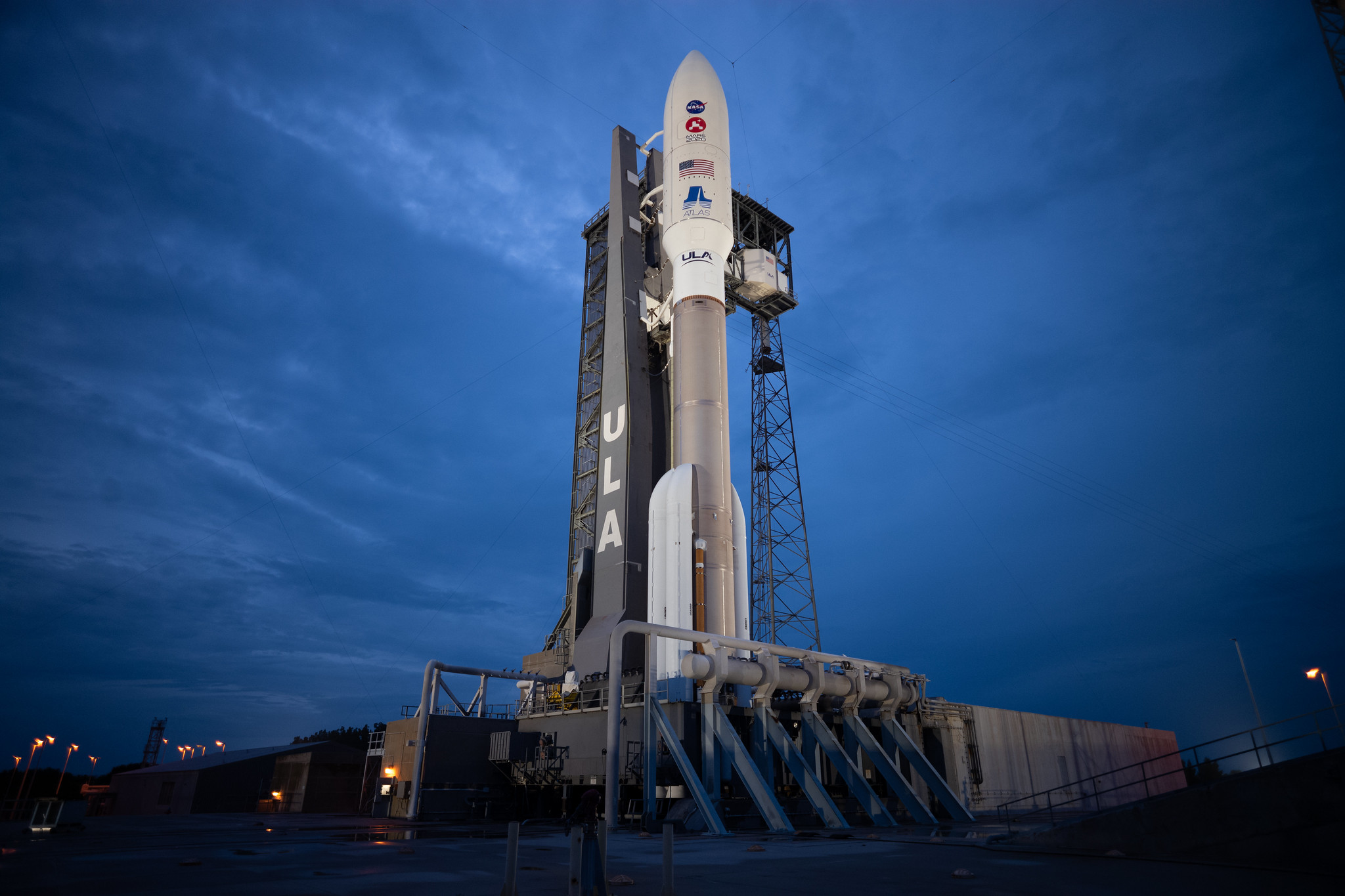
The clock is ticking down toward the launch of NASA’s Mars rover Perseverance. Here’s how you can watch the launch live at 7:50 a.m. EDT (1150 GMT) from Space Launch Complex 41 at the Cape Canaveral Air Force Station.
NASA’s webcast begins at 7 a.m. EDT (1100 GMT). The United Launch Alliance will begin its countdown coverage at 12:15 a.m. EDT (0415 GMT) with live updates appearing here.
Space.com contributor Amy Thompson is in Cape Canaveral for the Perseverance launch. Check out her preview of the mission and its launch day.
Spacesuit tech and a Mars microphone on Perseverance
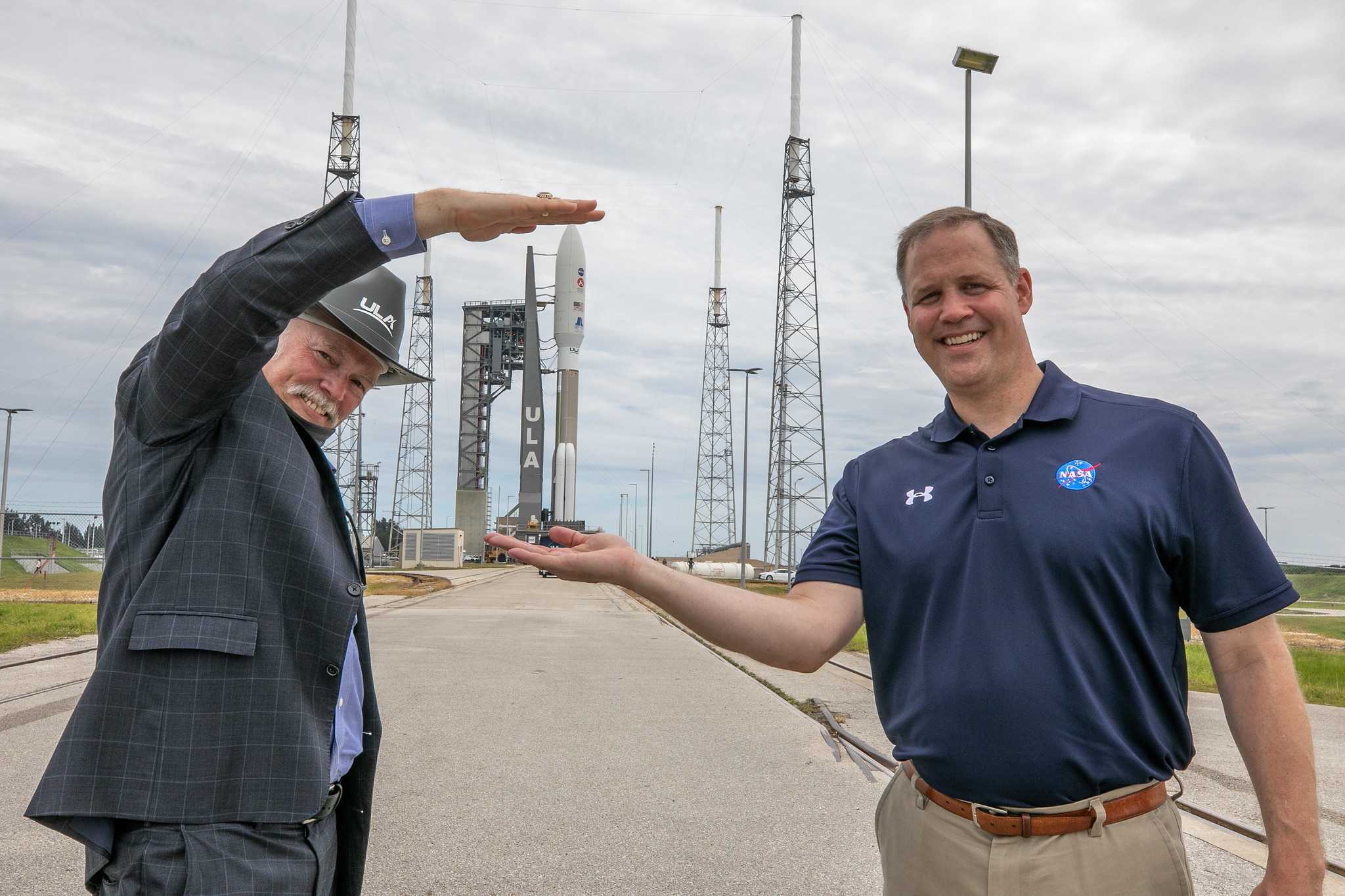
NASA is having some fun with less than a day remaining until the Mars 2020 Perseverance rover launches toward the Red Planet. In the photo above, you can see NASA Administrator Jim Bridenstine (right) and United Launch Alliance CEO Tory Bruno appear to “balance” the Atlas V carrying Perseverance at Space Launch Complex 41 of the Cape Canaveral Air Force Station.
NASA has even started streaming live views from the launch pad ahead of tomorrow’s live launch webcast, which will begin at 7 a.m. EDT (1100 GMT). Check it out here.
[embedded content]
But there’s some serious science still at work for the rover mission.
Did you know there are microphones on Perseverance to bring us the sounds of Mars? You can read all about here from Space.com contributor Elizabeth Howell.
Perseverance is also carrying a meteorite from Mars back to Mars as part of an experiment, according to collectSPACE.com editor Robert Pearlman. Pearlman also brings us this story about a piece of spacesuit material on Perseverance, which NASA will use to test spacesuit technology for future astronaut missions.
Space.com’s Chelsea Gohd took a look at how Perseverance will help the search for life on Mars. Check it out here.
Meanwhile, our senior writer Meghan Bartels dives in to the history of nuclear power on Mars and across the solar system. You can read that powerful story (see what we did there) here.
Finally, if you missed Space.com’s Summer of Mars panel today, don’t fret. You can catch the replay with Jim Watzin, director of NASA’s Mars Exploration Program, and Jim Bell, President of the Planetary Society. Check that out here.
NASA’s Dr. Z talks Mars rover Perseverance
We caught up with Dr. Thomas Zurbuchen, the Associate Administrator for the Science Mission Directorate at NASA, one day before NASA’s Mars 2020 Perseverance rover takes off for the Red Planet.
In the video chat (check it out above!) he detailed the incredibly innovative tools that Perseverence, nicknamed “Percy,” will carry to Mars and what makes the rover and mission so unique and important. He also highlighted some of his favorite aspects of the mission, which will collect and cache samples that researchers hope will be carried to Earth with a future mission.
One day from launch
We are less than 24 hours away from the launch of NASA’s Mars 2020 Perseverance rover! The rover will scour Mars for signs of ancient, microbial life.
Tomorrow at 7:50 a.m. EDT (1150 GMT), Percy will begin its journey to the Red Planet aboard a United Launch Alliance Atlas V rocket which will launch from Space Launch Complex 41 at Cape Canaveral Air Force Station in Florida.
It’s time to get excited and prepare yourself to watch and enjoy the historic launch.
Today, you can hear NASA Administrator Jim Bridenstine’s thoughts about the Mars-bound mission in a live-streamed video on NASA Live, which will begin at noon EST (1600 GMT.)
Also today, beginning at the same time, you can join Space.com for our “Summer of Mars” webinar, in which you’ll be able to connect with the Space.com community to discuss and learn about Perseverance, Mars, the search for life and so much more.
Go here for up-to-date information on how to watch the launch tomorrow live.
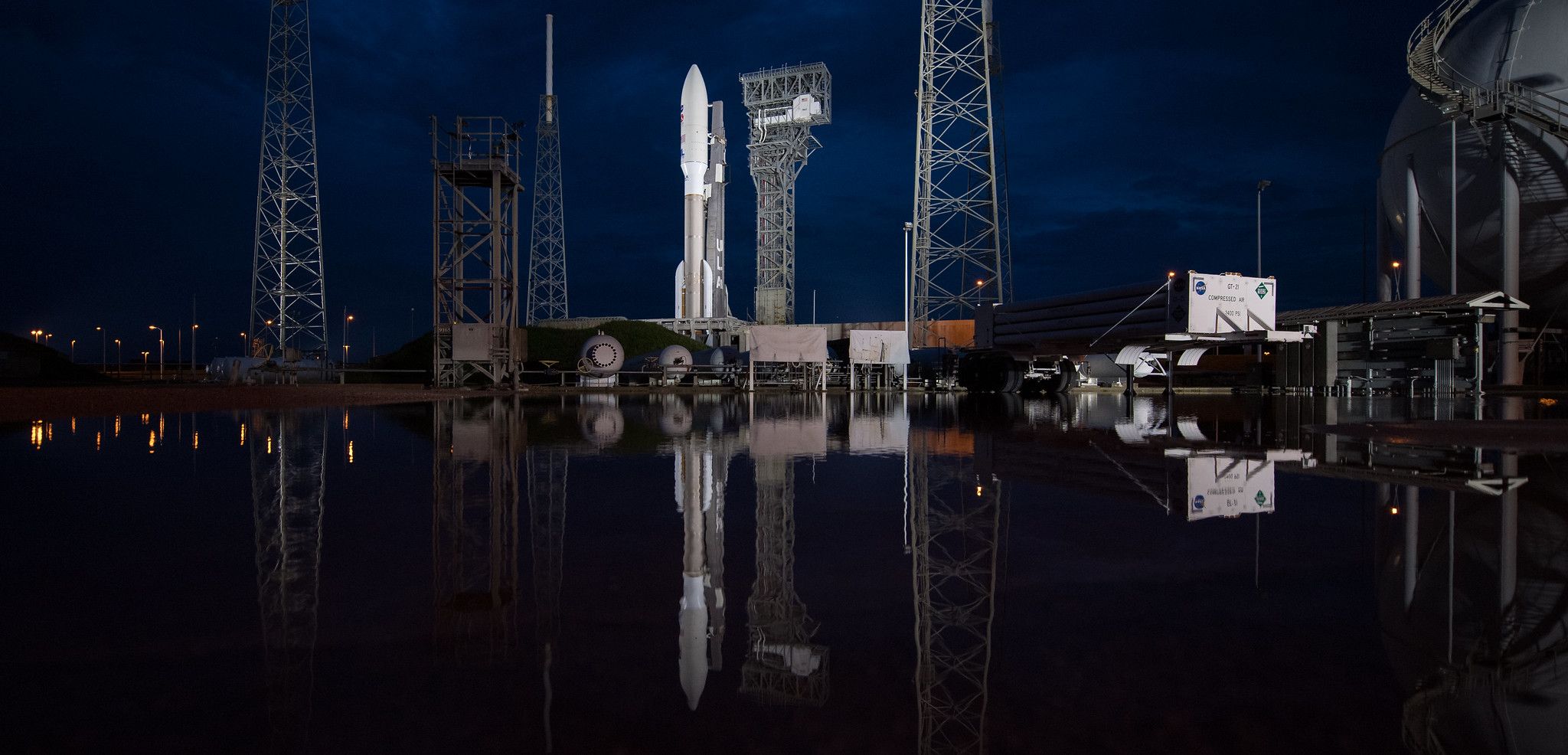
Mars rover Perseverance ‘go’ for launch
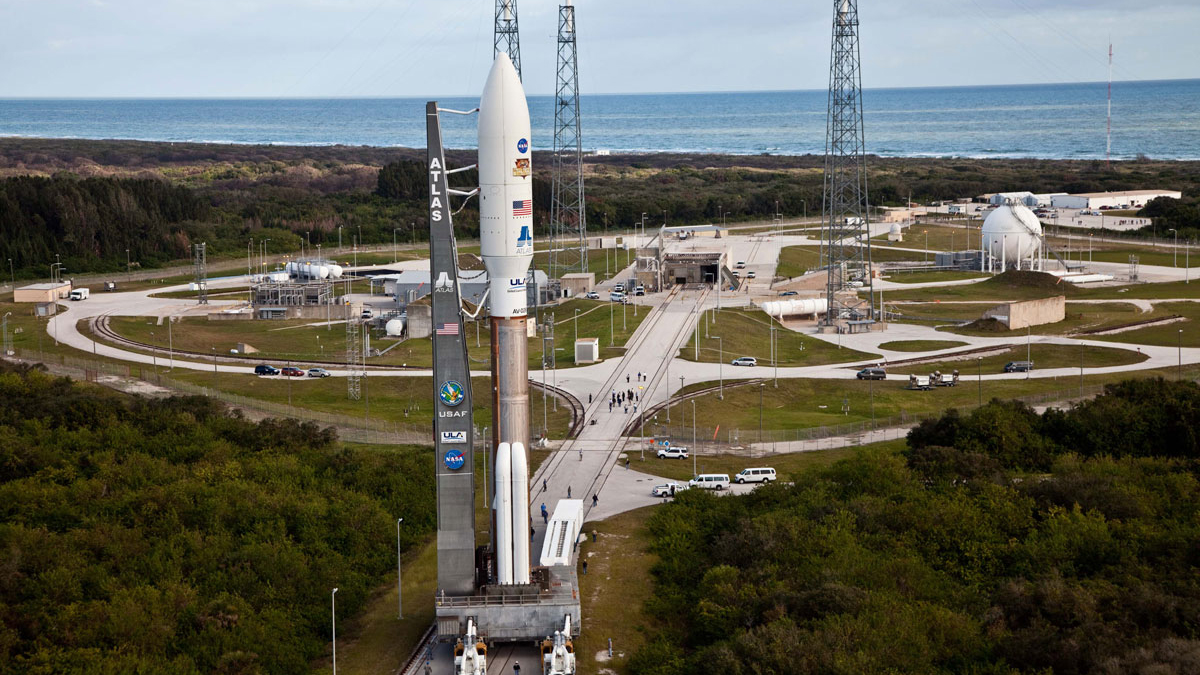
Perseverance, formerly known as the Mars 2020 rover, passed its launch readiness review, NASA officials announced today (July 27.) This was the last major hurdle before the rover is launched on Thursday (July 30) and so, with a pretty good weather forecast and this major obstacle behind it, the mission is making serious progress towards the Red Planet.



